Operations Management Issues and Success at Apple Inc.
VerifiedAdded on 2023/06/03
|22
|6186
|53
AI Summary
This article discusses the operational management issues affecting Apple Inc. such as changing technologies, market globalization, changing employee expectations, job designs, quality management, and global manufacturing. It also highlights the success factors of Apple Inc. such as quality management and resource management.
Contribute Materials
Your contribution can guide someone’s learning journey. Share your
documents today.
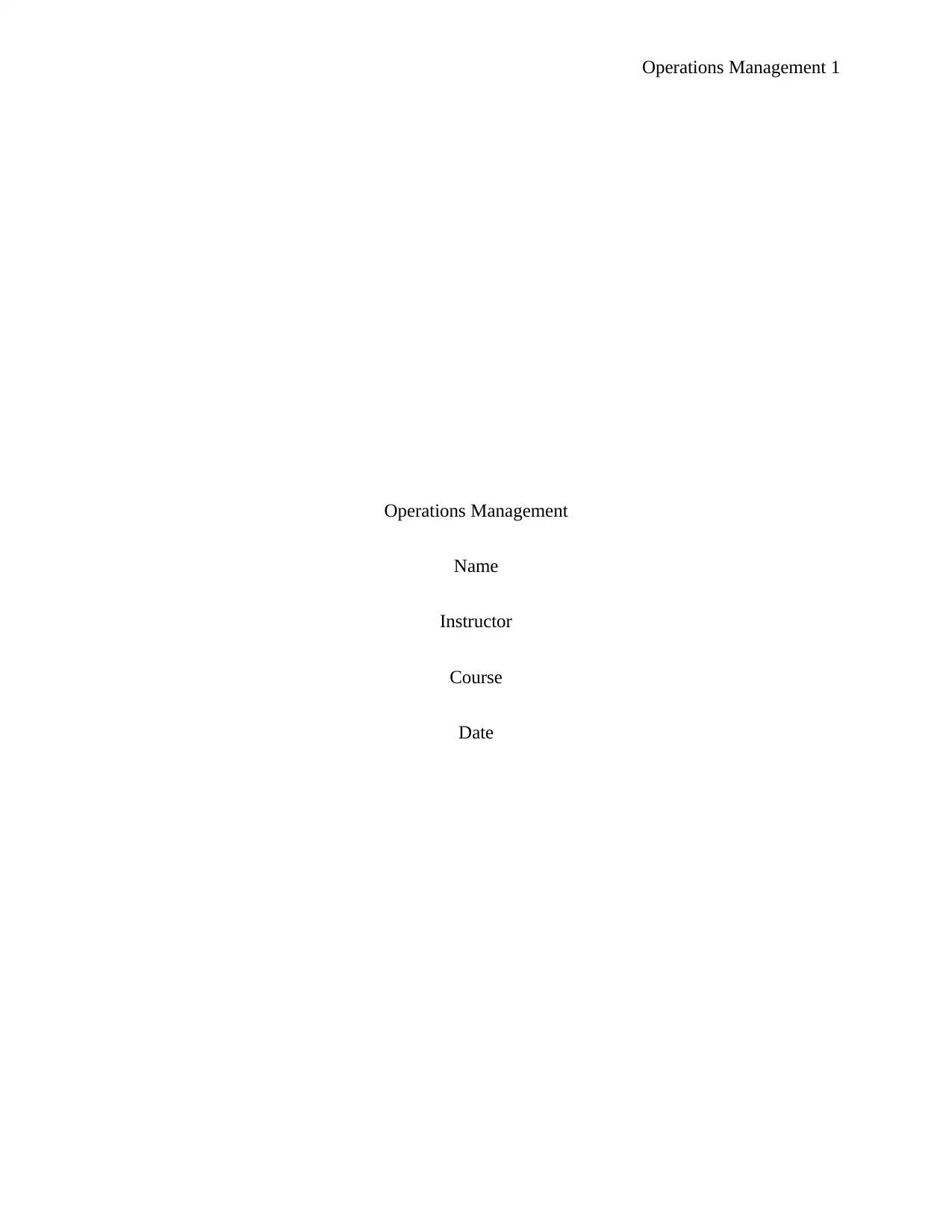
Operations Management 1
Operations Management
Name
Instructor
Course
Date
Operations Management
Name
Instructor
Course
Date
Secure Best Marks with AI Grader
Need help grading? Try our AI Grader for instant feedback on your assignments.
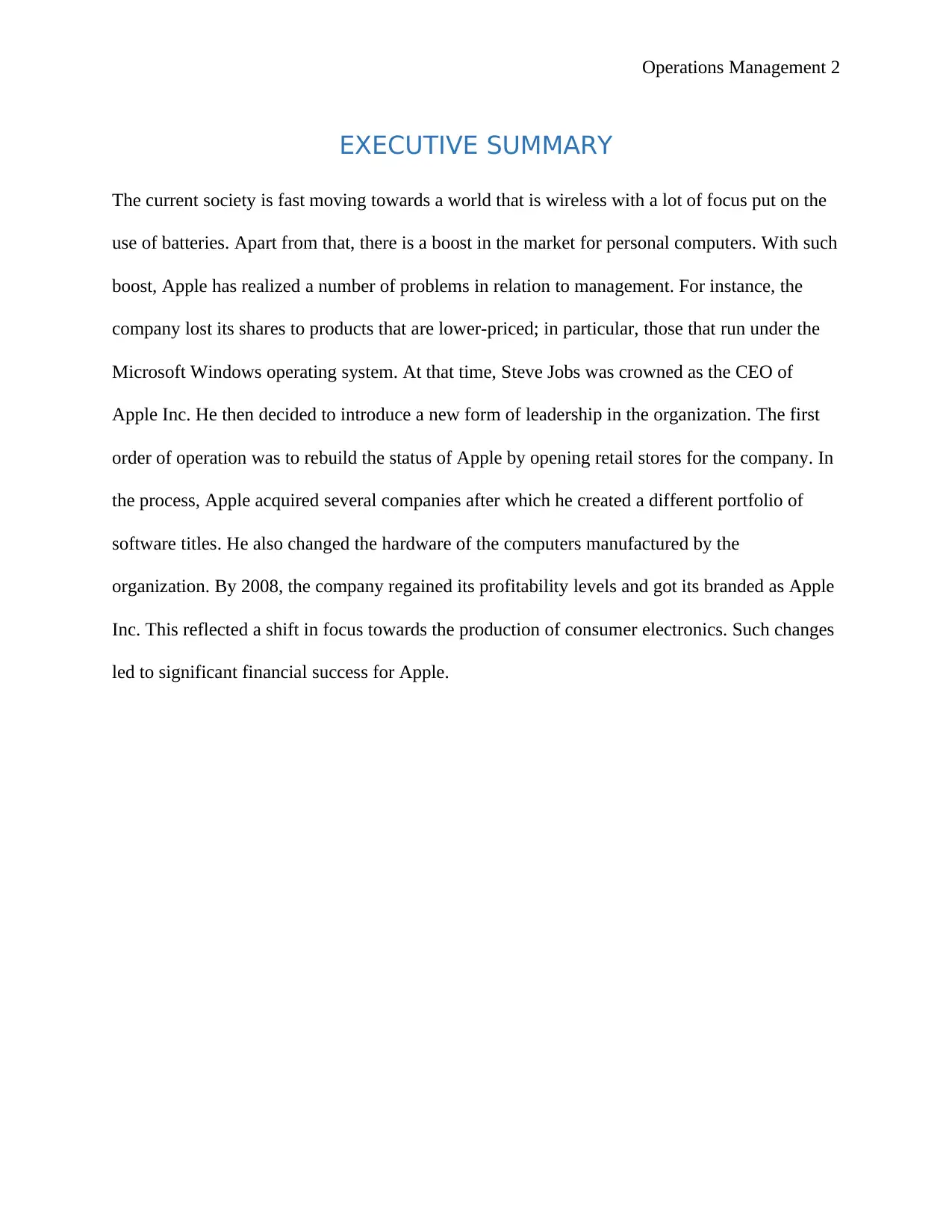
Operations Management 2
EXECUTIVE SUMMARY
The current society is fast moving towards a world that is wireless with a lot of focus put on the
use of batteries. Apart from that, there is a boost in the market for personal computers. With such
boost, Apple has realized a number of problems in relation to management. For instance, the
company lost its shares to products that are lower-priced; in particular, those that run under the
Microsoft Windows operating system. At that time, Steve Jobs was crowned as the CEO of
Apple Inc. He then decided to introduce a new form of leadership in the organization. The first
order of operation was to rebuild the status of Apple by opening retail stores for the company. In
the process, Apple acquired several companies after which he created a different portfolio of
software titles. He also changed the hardware of the computers manufactured by the
organization. By 2008, the company regained its profitability levels and got its branded as Apple
Inc. This reflected a shift in focus towards the production of consumer electronics. Such changes
led to significant financial success for Apple.
EXECUTIVE SUMMARY
The current society is fast moving towards a world that is wireless with a lot of focus put on the
use of batteries. Apart from that, there is a boost in the market for personal computers. With such
boost, Apple has realized a number of problems in relation to management. For instance, the
company lost its shares to products that are lower-priced; in particular, those that run under the
Microsoft Windows operating system. At that time, Steve Jobs was crowned as the CEO of
Apple Inc. He then decided to introduce a new form of leadership in the organization. The first
order of operation was to rebuild the status of Apple by opening retail stores for the company. In
the process, Apple acquired several companies after which he created a different portfolio of
software titles. He also changed the hardware of the computers manufactured by the
organization. By 2008, the company regained its profitability levels and got its branded as Apple
Inc. This reflected a shift in focus towards the production of consumer electronics. Such changes
led to significant financial success for Apple.

Operations Management 3
Contents
EXECUTIVE SUMMARY.............................................................................................................2
INTRODUCTION...........................................................................................................................5
A. Operations Management Issues to Affect Future Growth....................................................5
1. Impacts of Changing Technologies..........................................................................................6
2. Impacts of Continued Market Globalization............................................................................7
i) Globalization.........................................................................................................................8
3. Impacts of Changing Employee Expectations..........................................................................8
4. Impacts of Changing Job Designs............................................................................................9
i) Use of Space.........................................................................................................................9
ii) Increased Productivity.....................................................................................................10
iii) Collaboration...................................................................................................................10
5. Quality Management..............................................................................................................10
6. Global Manufacturing............................................................................................................11
B. Operation Management Issues to Cause Success...............................................................11
1. Quality Management..............................................................................................................11
2. Resource Management...........................................................................................................13
i) Selection and Recruitment..................................................................................................14
ii) Equal Employment Opportunities and Diversity............................................................14
iii) Compensation and Employment Benefits.......................................................................15
Contents
EXECUTIVE SUMMARY.............................................................................................................2
INTRODUCTION...........................................................................................................................5
A. Operations Management Issues to Affect Future Growth....................................................5
1. Impacts of Changing Technologies..........................................................................................6
2. Impacts of Continued Market Globalization............................................................................7
i) Globalization.........................................................................................................................8
3. Impacts of Changing Employee Expectations..........................................................................8
4. Impacts of Changing Job Designs............................................................................................9
i) Use of Space.........................................................................................................................9
ii) Increased Productivity.....................................................................................................10
iii) Collaboration...................................................................................................................10
5. Quality Management..............................................................................................................10
6. Global Manufacturing............................................................................................................11
B. Operation Management Issues to Cause Success...............................................................11
1. Quality Management..............................................................................................................11
2. Resource Management...........................................................................................................13
i) Selection and Recruitment..................................................................................................14
ii) Equal Employment Opportunities and Diversity............................................................14
iii) Compensation and Employment Benefits.......................................................................15
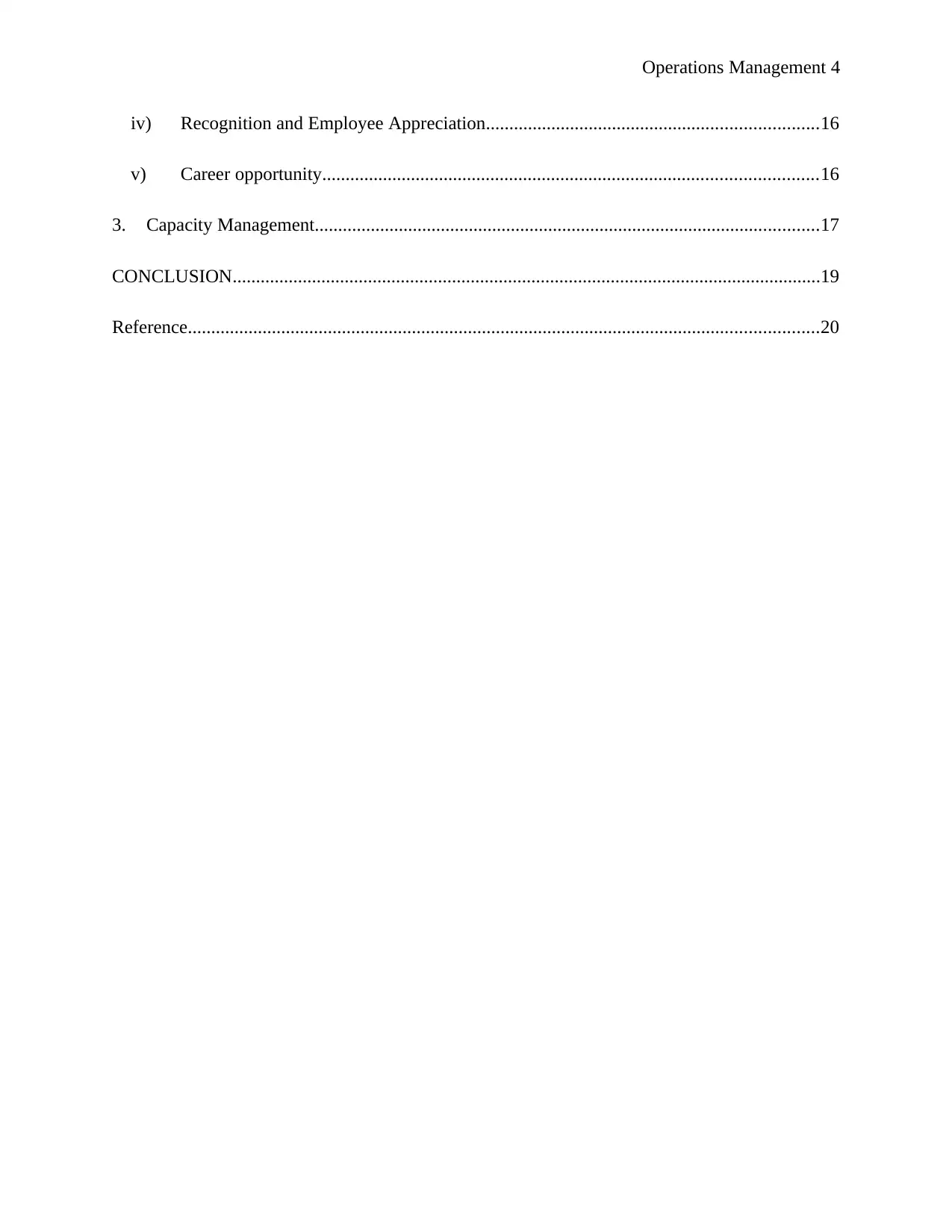
Operations Management 4
iv) Recognition and Employee Appreciation.......................................................................16
v) Career opportunity..........................................................................................................16
3. Capacity Management............................................................................................................17
CONCLUSION..............................................................................................................................19
Reference.......................................................................................................................................20
iv) Recognition and Employee Appreciation.......................................................................16
v) Career opportunity..........................................................................................................16
3. Capacity Management............................................................................................................17
CONCLUSION..............................................................................................................................19
Reference.......................................................................................................................................20
Secure Best Marks with AI Grader
Need help grading? Try our AI Grader for instant feedback on your assignments.

Operations Management 5
Apple Inc.
INTRODUCTION
Apple Corporation, known to many as Apple Inc., is a multinational corporation whose
headquarters are in Cupertino, California. This company deals in the design, development, and
selling of electronics, online services, and computer software (Christie and Warburton, 2017).
Some of the hardware products that Apple deal in are iPad tablets, iPhone smartphone, Mac PCs,
iPods, Apple TVs, Apple Watch smartwatches, HomePod speakers, and digital media players.
On the same note, Apple software include iOS and macOS operating systems, the Safari web
browser, the iTunes media player, iWork and iLife creativity, productivity suites, and
professional applications such as Logic Pro, Final Cut Pro, and Xcode (Alier, 2016, pg. 134).
In relation to the production line of Apple Inc., this activity will discuss issues affecting the
general operations of Apple Inc. such as:
- Changing Technologies
- Continued Market Globalization including the 1st and 2nd world entrants.
- Changing Employee Expectations
- Changing job designs
- Quality Management and;
- Global manufacturing
A. Operations Management Issues to Affect Future Growth
In the sector of operational management, a couple of challenges have hindered Apple Inc. as well
as other multinational organizations worldwide from achieving ultimate success. This paper, in
Apple Inc.
INTRODUCTION
Apple Corporation, known to many as Apple Inc., is a multinational corporation whose
headquarters are in Cupertino, California. This company deals in the design, development, and
selling of electronics, online services, and computer software (Christie and Warburton, 2017).
Some of the hardware products that Apple deal in are iPad tablets, iPhone smartphone, Mac PCs,
iPods, Apple TVs, Apple Watch smartwatches, HomePod speakers, and digital media players.
On the same note, Apple software include iOS and macOS operating systems, the Safari web
browser, the iTunes media player, iWork and iLife creativity, productivity suites, and
professional applications such as Logic Pro, Final Cut Pro, and Xcode (Alier, 2016, pg. 134).
In relation to the production line of Apple Inc., this activity will discuss issues affecting the
general operations of Apple Inc. such as:
- Changing Technologies
- Continued Market Globalization including the 1st and 2nd world entrants.
- Changing Employee Expectations
- Changing job designs
- Quality Management and;
- Global manufacturing
A. Operations Management Issues to Affect Future Growth
In the sector of operational management, a couple of challenges have hindered Apple Inc. as well
as other multinational organizations worldwide from achieving ultimate success. This paper, in
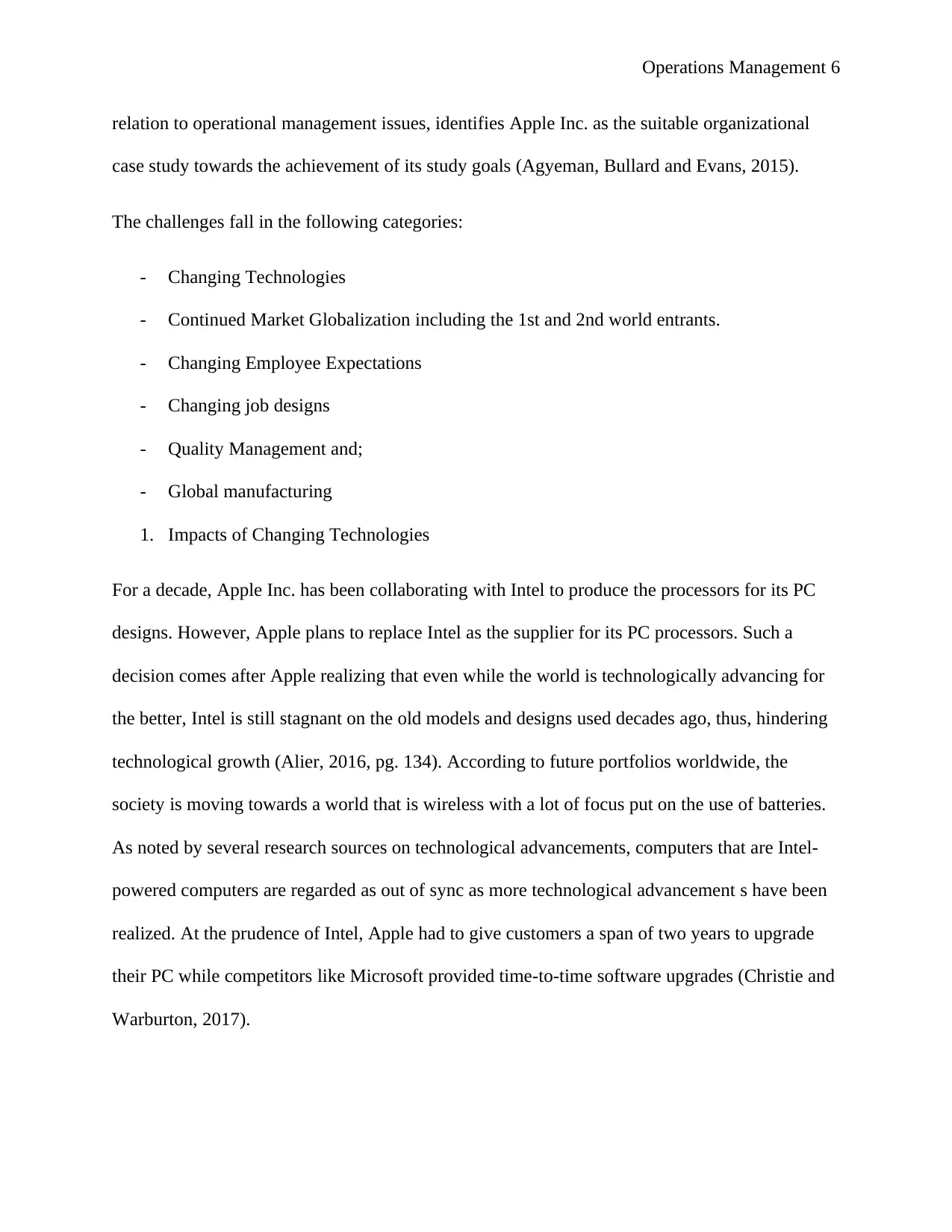
Operations Management 6
relation to operational management issues, identifies Apple Inc. as the suitable organizational
case study towards the achievement of its study goals (Agyeman, Bullard and Evans, 2015).
The challenges fall in the following categories:
- Changing Technologies
- Continued Market Globalization including the 1st and 2nd world entrants.
- Changing Employee Expectations
- Changing job designs
- Quality Management and;
- Global manufacturing
1. Impacts of Changing Technologies
For a decade, Apple Inc. has been collaborating with Intel to produce the processors for its PC
designs. However, Apple plans to replace Intel as the supplier for its PC processors. Such a
decision comes after Apple realizing that even while the world is technologically advancing for
the better, Intel is still stagnant on the old models and designs used decades ago, thus, hindering
technological growth (Alier, 2016, pg. 134). According to future portfolios worldwide, the
society is moving towards a world that is wireless with a lot of focus put on the use of batteries.
As noted by several research sources on technological advancements, computers that are Intel-
powered computers are regarded as out of sync as more technological advancement s have been
realized. At the prudence of Intel, Apple had to give customers a span of two years to upgrade
their PC while competitors like Microsoft provided time-to-time software upgrades (Christie and
Warburton, 2017).
relation to operational management issues, identifies Apple Inc. as the suitable organizational
case study towards the achievement of its study goals (Agyeman, Bullard and Evans, 2015).
The challenges fall in the following categories:
- Changing Technologies
- Continued Market Globalization including the 1st and 2nd world entrants.
- Changing Employee Expectations
- Changing job designs
- Quality Management and;
- Global manufacturing
1. Impacts of Changing Technologies
For a decade, Apple Inc. has been collaborating with Intel to produce the processors for its PC
designs. However, Apple plans to replace Intel as the supplier for its PC processors. Such a
decision comes after Apple realizing that even while the world is technologically advancing for
the better, Intel is still stagnant on the old models and designs used decades ago, thus, hindering
technological growth (Alier, 2016, pg. 134). According to future portfolios worldwide, the
society is moving towards a world that is wireless with a lot of focus put on the use of batteries.
As noted by several research sources on technological advancements, computers that are Intel-
powered computers are regarded as out of sync as more technological advancement s have been
realized. At the prudence of Intel, Apple had to give customers a span of two years to upgrade
their PC while competitors like Microsoft provided time-to-time software upgrades (Christie and
Warburton, 2017).
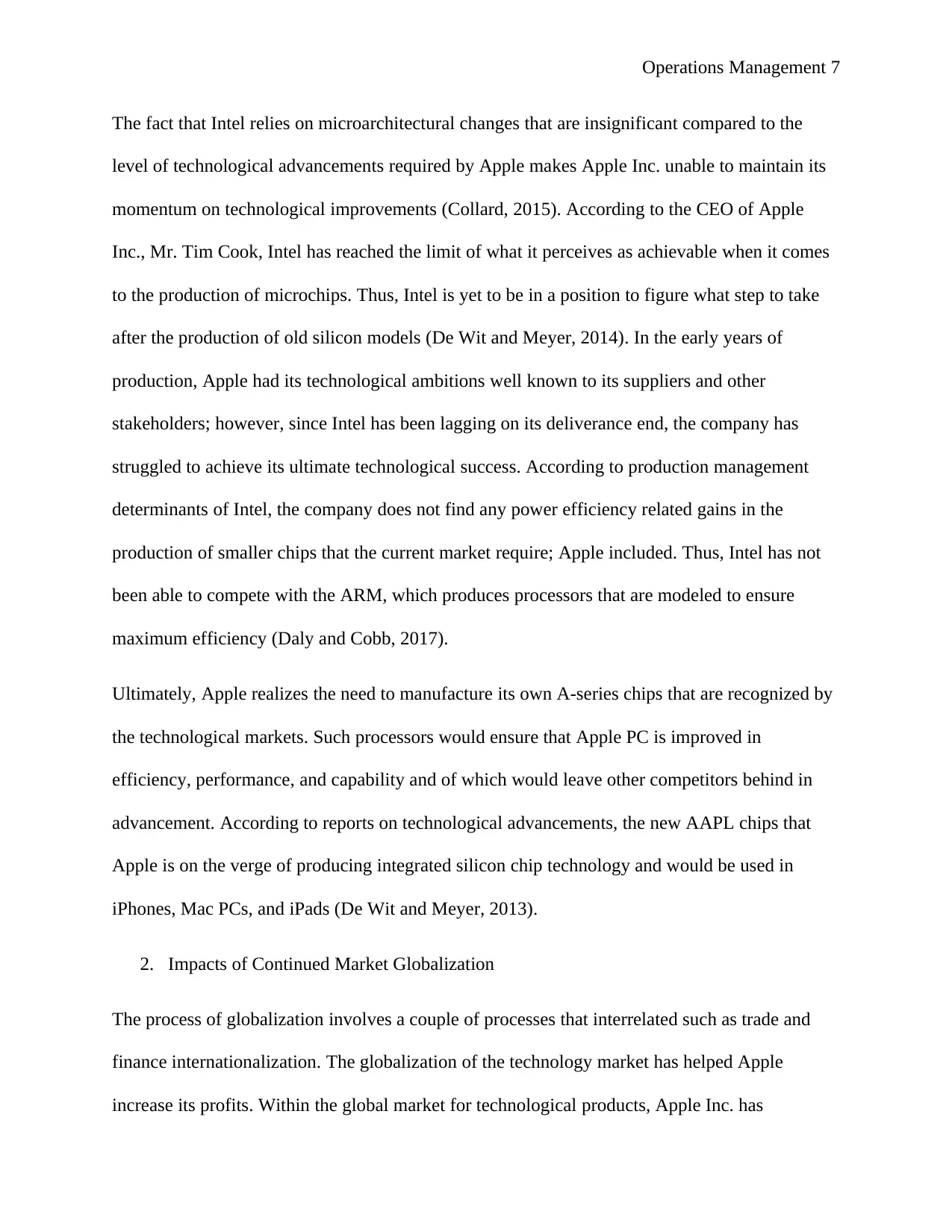
Operations Management 7
The fact that Intel relies on microarchitectural changes that are insignificant compared to the
level of technological advancements required by Apple makes Apple Inc. unable to maintain its
momentum on technological improvements (Collard, 2015). According to the CEO of Apple
Inc., Mr. Tim Cook, Intel has reached the limit of what it perceives as achievable when it comes
to the production of microchips. Thus, Intel is yet to be in a position to figure what step to take
after the production of old silicon models (De Wit and Meyer, 2014). In the early years of
production, Apple had its technological ambitions well known to its suppliers and other
stakeholders; however, since Intel has been lagging on its deliverance end, the company has
struggled to achieve its ultimate technological success. According to production management
determinants of Intel, the company does not find any power efficiency related gains in the
production of smaller chips that the current market require; Apple included. Thus, Intel has not
been able to compete with the ARM, which produces processors that are modeled to ensure
maximum efficiency (Daly and Cobb, 2017).
Ultimately, Apple realizes the need to manufacture its own A-series chips that are recognized by
the technological markets. Such processors would ensure that Apple PC is improved in
efficiency, performance, and capability and of which would leave other competitors behind in
advancement. According to reports on technological advancements, the new AAPL chips that
Apple is on the verge of producing integrated silicon chip technology and would be used in
iPhones, Mac PCs, and iPads (De Wit and Meyer, 2013).
2. Impacts of Continued Market Globalization
The process of globalization involves a couple of processes that interrelated such as trade and
finance internationalization. The globalization of the technology market has helped Apple
increase its profits. Within the global market for technological products, Apple Inc. has
The fact that Intel relies on microarchitectural changes that are insignificant compared to the
level of technological advancements required by Apple makes Apple Inc. unable to maintain its
momentum on technological improvements (Collard, 2015). According to the CEO of Apple
Inc., Mr. Tim Cook, Intel has reached the limit of what it perceives as achievable when it comes
to the production of microchips. Thus, Intel is yet to be in a position to figure what step to take
after the production of old silicon models (De Wit and Meyer, 2014). In the early years of
production, Apple had its technological ambitions well known to its suppliers and other
stakeholders; however, since Intel has been lagging on its deliverance end, the company has
struggled to achieve its ultimate technological success. According to production management
determinants of Intel, the company does not find any power efficiency related gains in the
production of smaller chips that the current market require; Apple included. Thus, Intel has not
been able to compete with the ARM, which produces processors that are modeled to ensure
maximum efficiency (Daly and Cobb, 2017).
Ultimately, Apple realizes the need to manufacture its own A-series chips that are recognized by
the technological markets. Such processors would ensure that Apple PC is improved in
efficiency, performance, and capability and of which would leave other competitors behind in
advancement. According to reports on technological advancements, the new AAPL chips that
Apple is on the verge of producing integrated silicon chip technology and would be used in
iPhones, Mac PCs, and iPads (De Wit and Meyer, 2013).
2. Impacts of Continued Market Globalization
The process of globalization involves a couple of processes that interrelated such as trade and
finance internationalization. The globalization of the technology market has helped Apple
increase its profits. Within the global market for technological products, Apple Inc. has
Paraphrase This Document
Need a fresh take? Get an instant paraphrase of this document with our AI Paraphraser
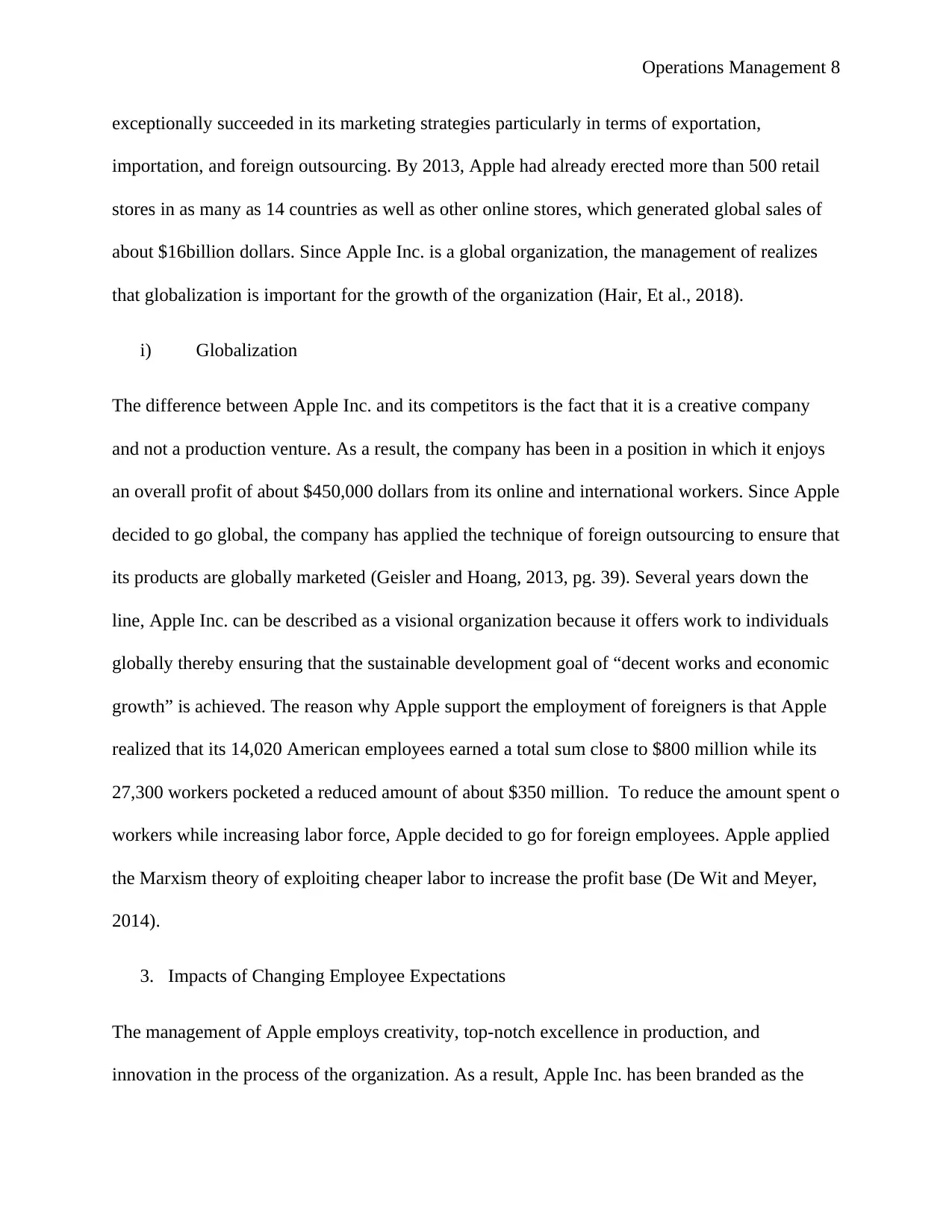
Operations Management 8
exceptionally succeeded in its marketing strategies particularly in terms of exportation,
importation, and foreign outsourcing. By 2013, Apple had already erected more than 500 retail
stores in as many as 14 countries as well as other online stores, which generated global sales of
about $16billion dollars. Since Apple Inc. is a global organization, the management of realizes
that globalization is important for the growth of the organization (Hair, Et al., 2018).
i) Globalization
The difference between Apple Inc. and its competitors is the fact that it is a creative company
and not a production venture. As a result, the company has been in a position in which it enjoys
an overall profit of about $450,000 dollars from its online and international workers. Since Apple
decided to go global, the company has applied the technique of foreign outsourcing to ensure that
its products are globally marketed (Geisler and Hoang, 2013, pg. 39). Several years down the
line, Apple Inc. can be described as a visional organization because it offers work to individuals
globally thereby ensuring that the sustainable development goal of “decent works and economic
growth” is achieved. The reason why Apple support the employment of foreigners is that Apple
realized that its 14,020 American employees earned a total sum close to $800 million while its
27,300 workers pocketed a reduced amount of about $350 million. To reduce the amount spent o
workers while increasing labor force, Apple decided to go for foreign employees. Apple applied
the Marxism theory of exploiting cheaper labor to increase the profit base (De Wit and Meyer,
2014).
3. Impacts of Changing Employee Expectations
The management of Apple employs creativity, top-notch excellence in production, and
innovation in the process of the organization. As a result, Apple Inc. has been branded as the
exceptionally succeeded in its marketing strategies particularly in terms of exportation,
importation, and foreign outsourcing. By 2013, Apple had already erected more than 500 retail
stores in as many as 14 countries as well as other online stores, which generated global sales of
about $16billion dollars. Since Apple Inc. is a global organization, the management of realizes
that globalization is important for the growth of the organization (Hair, Et al., 2018).
i) Globalization
The difference between Apple Inc. and its competitors is the fact that it is a creative company
and not a production venture. As a result, the company has been in a position in which it enjoys
an overall profit of about $450,000 dollars from its online and international workers. Since Apple
decided to go global, the company has applied the technique of foreign outsourcing to ensure that
its products are globally marketed (Geisler and Hoang, 2013, pg. 39). Several years down the
line, Apple Inc. can be described as a visional organization because it offers work to individuals
globally thereby ensuring that the sustainable development goal of “decent works and economic
growth” is achieved. The reason why Apple support the employment of foreigners is that Apple
realized that its 14,020 American employees earned a total sum close to $800 million while its
27,300 workers pocketed a reduced amount of about $350 million. To reduce the amount spent o
workers while increasing labor force, Apple decided to go for foreign employees. Apple applied
the Marxism theory of exploiting cheaper labor to increase the profit base (De Wit and Meyer,
2014).
3. Impacts of Changing Employee Expectations
The management of Apple employs creativity, top-notch excellence in production, and
innovation in the process of the organization. As a result, Apple Inc. has been branded as the
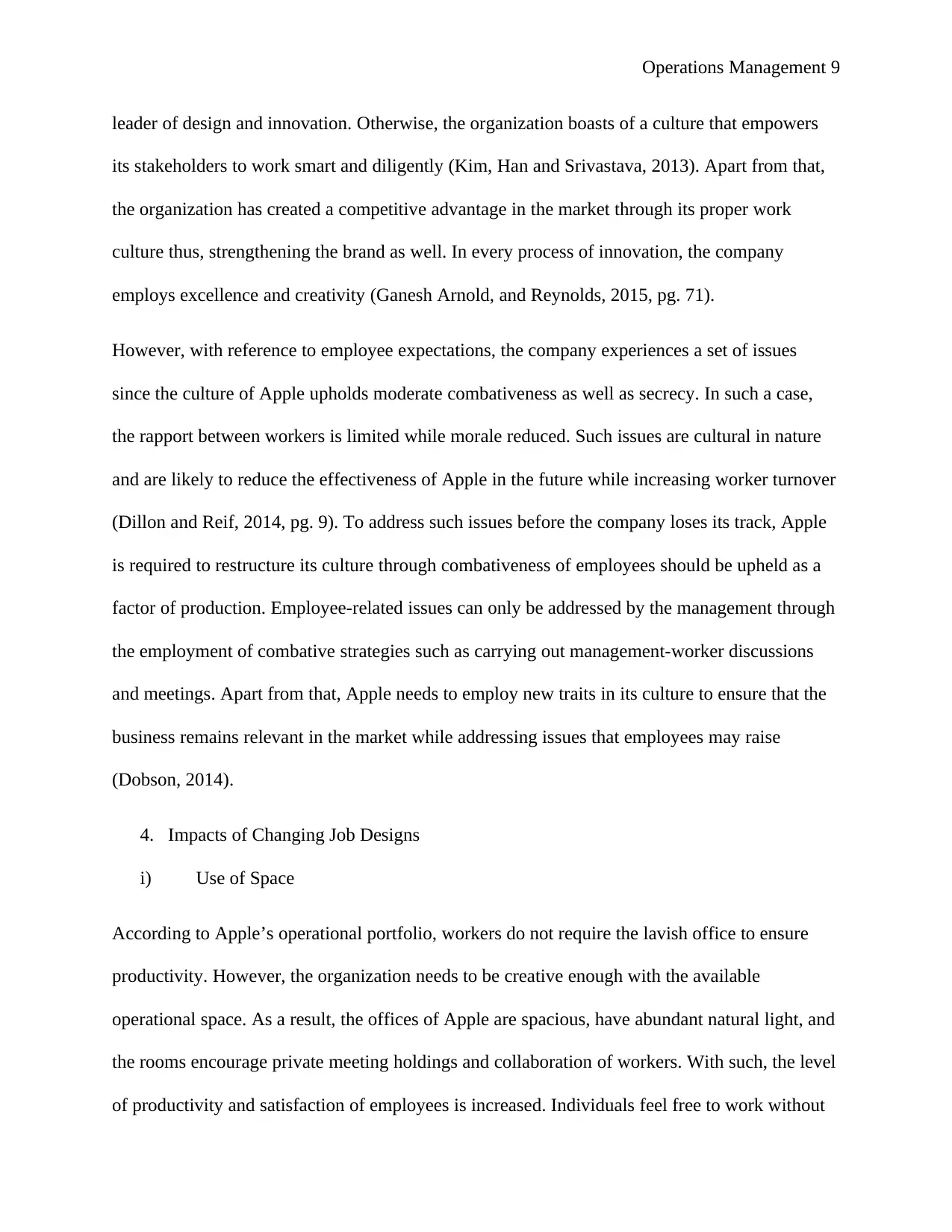
Operations Management 9
leader of design and innovation. Otherwise, the organization boasts of a culture that empowers
its stakeholders to work smart and diligently (Kim, Han and Srivastava, 2013). Apart from that,
the organization has created a competitive advantage in the market through its proper work
culture thus, strengthening the brand as well. In every process of innovation, the company
employs excellence and creativity (Ganesh Arnold, and Reynolds, 2015, pg. 71).
However, with reference to employee expectations, the company experiences a set of issues
since the culture of Apple upholds moderate combativeness as well as secrecy. In such a case,
the rapport between workers is limited while morale reduced. Such issues are cultural in nature
and are likely to reduce the effectiveness of Apple in the future while increasing worker turnover
(Dillon and Reif, 2014, pg. 9). To address such issues before the company loses its track, Apple
is required to restructure its culture through combativeness of employees should be upheld as a
factor of production. Employee-related issues can only be addressed by the management through
the employment of combative strategies such as carrying out management-worker discussions
and meetings. Apart from that, Apple needs to employ new traits in its culture to ensure that the
business remains relevant in the market while addressing issues that employees may raise
(Dobson, 2014).
4. Impacts of Changing Job Designs
i) Use of Space
According to Apple’s operational portfolio, workers do not require the lavish office to ensure
productivity. However, the organization needs to be creative enough with the available
operational space. As a result, the offices of Apple are spacious, have abundant natural light, and
the rooms encourage private meeting holdings and collaboration of workers. With such, the level
of productivity and satisfaction of employees is increased. Individuals feel free to work without
leader of design and innovation. Otherwise, the organization boasts of a culture that empowers
its stakeholders to work smart and diligently (Kim, Han and Srivastava, 2013). Apart from that,
the organization has created a competitive advantage in the market through its proper work
culture thus, strengthening the brand as well. In every process of innovation, the company
employs excellence and creativity (Ganesh Arnold, and Reynolds, 2015, pg. 71).
However, with reference to employee expectations, the company experiences a set of issues
since the culture of Apple upholds moderate combativeness as well as secrecy. In such a case,
the rapport between workers is limited while morale reduced. Such issues are cultural in nature
and are likely to reduce the effectiveness of Apple in the future while increasing worker turnover
(Dillon and Reif, 2014, pg. 9). To address such issues before the company loses its track, Apple
is required to restructure its culture through combativeness of employees should be upheld as a
factor of production. Employee-related issues can only be addressed by the management through
the employment of combative strategies such as carrying out management-worker discussions
and meetings. Apart from that, Apple needs to employ new traits in its culture to ensure that the
business remains relevant in the market while addressing issues that employees may raise
(Dobson, 2014).
4. Impacts of Changing Job Designs
i) Use of Space
According to Apple’s operational portfolio, workers do not require the lavish office to ensure
productivity. However, the organization needs to be creative enough with the available
operational space. As a result, the offices of Apple are spacious, have abundant natural light, and
the rooms encourage private meeting holdings and collaboration of workers. With such, the level
of productivity and satisfaction of employees is increased. Individuals feel free to work without
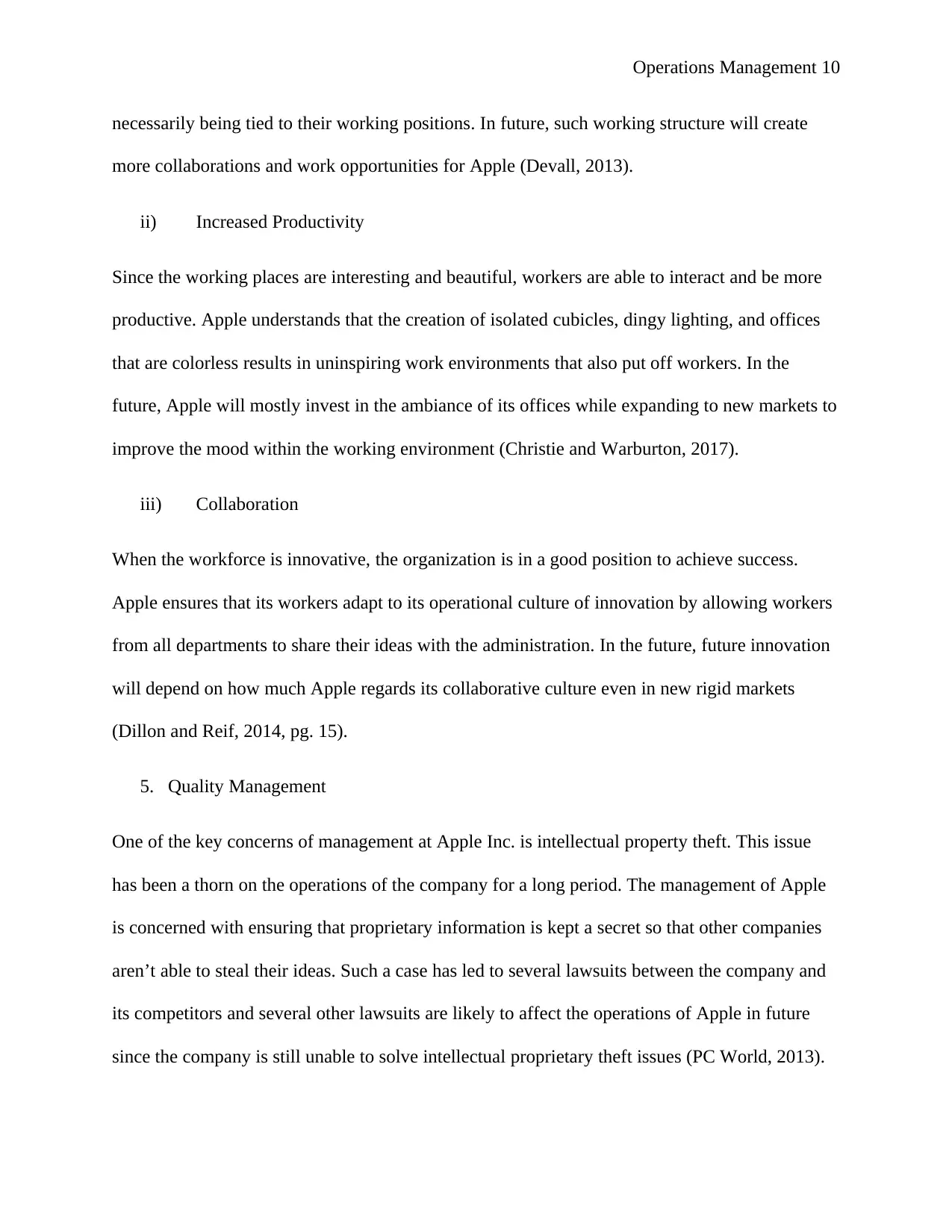
Operations Management 10
necessarily being tied to their working positions. In future, such working structure will create
more collaborations and work opportunities for Apple (Devall, 2013).
ii) Increased Productivity
Since the working places are interesting and beautiful, workers are able to interact and be more
productive. Apple understands that the creation of isolated cubicles, dingy lighting, and offices
that are colorless results in uninspiring work environments that also put off workers. In the
future, Apple will mostly invest in the ambiance of its offices while expanding to new markets to
improve the mood within the working environment (Christie and Warburton, 2017).
iii) Collaboration
When the workforce is innovative, the organization is in a good position to achieve success.
Apple ensures that its workers adapt to its operational culture of innovation by allowing workers
from all departments to share their ideas with the administration. In the future, future innovation
will depend on how much Apple regards its collaborative culture even in new rigid markets
(Dillon and Reif, 2014, pg. 15).
5. Quality Management
One of the key concerns of management at Apple Inc. is intellectual property theft. This issue
has been a thorn on the operations of the company for a long period. The management of Apple
is concerned with ensuring that proprietary information is kept a secret so that other companies
aren’t able to steal their ideas. Such a case has led to several lawsuits between the company and
its competitors and several other lawsuits are likely to affect the operations of Apple in future
since the company is still unable to solve intellectual proprietary theft issues (PC World, 2013).
necessarily being tied to their working positions. In future, such working structure will create
more collaborations and work opportunities for Apple (Devall, 2013).
ii) Increased Productivity
Since the working places are interesting and beautiful, workers are able to interact and be more
productive. Apple understands that the creation of isolated cubicles, dingy lighting, and offices
that are colorless results in uninspiring work environments that also put off workers. In the
future, Apple will mostly invest in the ambiance of its offices while expanding to new markets to
improve the mood within the working environment (Christie and Warburton, 2017).
iii) Collaboration
When the workforce is innovative, the organization is in a good position to achieve success.
Apple ensures that its workers adapt to its operational culture of innovation by allowing workers
from all departments to share their ideas with the administration. In the future, future innovation
will depend on how much Apple regards its collaborative culture even in new rigid markets
(Dillon and Reif, 2014, pg. 15).
5. Quality Management
One of the key concerns of management at Apple Inc. is intellectual property theft. This issue
has been a thorn on the operations of the company for a long period. The management of Apple
is concerned with ensuring that proprietary information is kept a secret so that other companies
aren’t able to steal their ideas. Such a case has led to several lawsuits between the company and
its competitors and several other lawsuits are likely to affect the operations of Apple in future
since the company is still unable to solve intellectual proprietary theft issues (PC World, 2013).
Secure Best Marks with AI Grader
Need help grading? Try our AI Grader for instant feedback on your assignments.
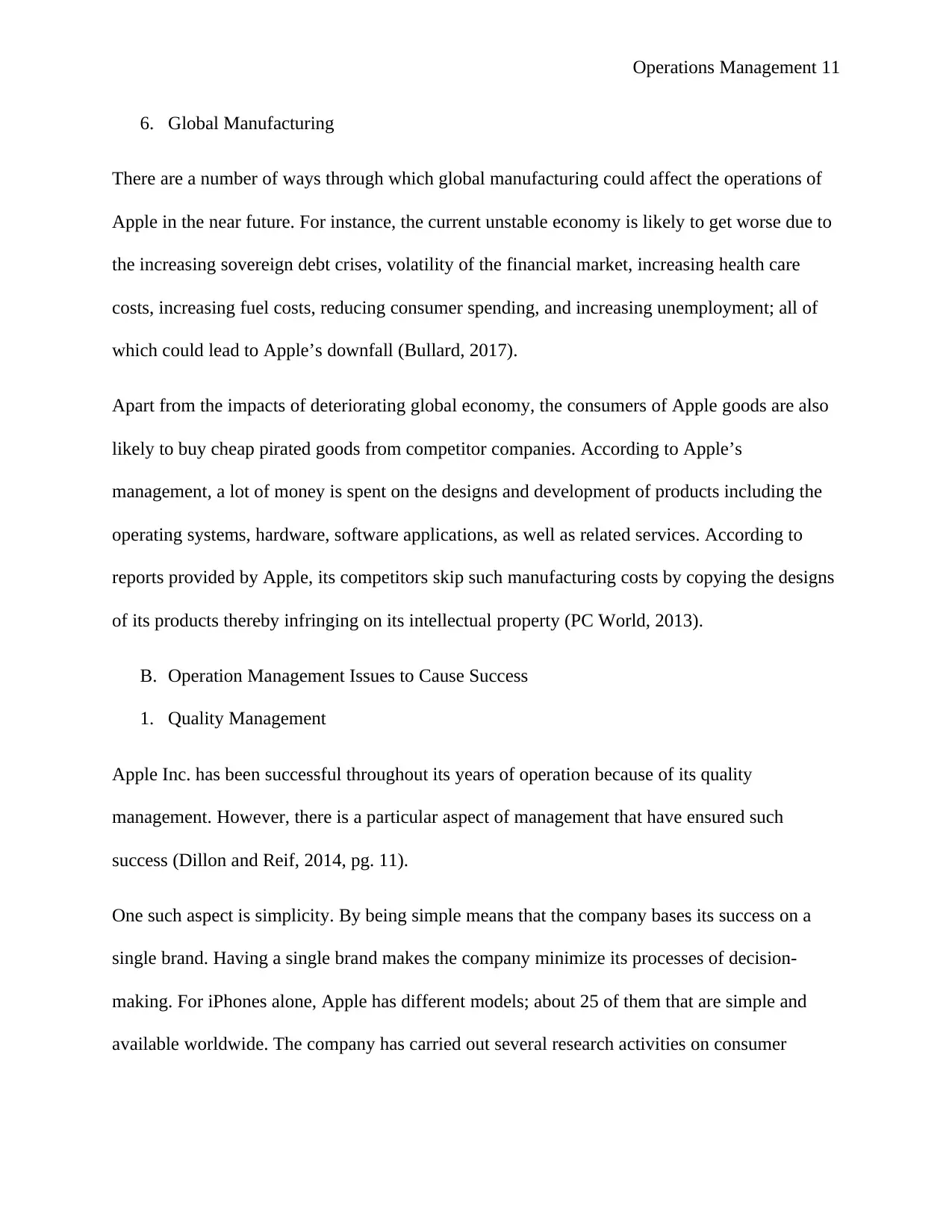
Operations Management 11
6. Global Manufacturing
There are a number of ways through which global manufacturing could affect the operations of
Apple in the near future. For instance, the current unstable economy is likely to get worse due to
the increasing sovereign debt crises, volatility of the financial market, increasing health care
costs, increasing fuel costs, reducing consumer spending, and increasing unemployment; all of
which could lead to Apple’s downfall (Bullard, 2017).
Apart from the impacts of deteriorating global economy, the consumers of Apple goods are also
likely to buy cheap pirated goods from competitor companies. According to Apple’s
management, a lot of money is spent on the designs and development of products including the
operating systems, hardware, software applications, as well as related services. According to
reports provided by Apple, its competitors skip such manufacturing costs by copying the designs
of its products thereby infringing on its intellectual property (PC World, 2013).
B. Operation Management Issues to Cause Success
1. Quality Management
Apple Inc. has been successful throughout its years of operation because of its quality
management. However, there is a particular aspect of management that have ensured such
success (Dillon and Reif, 2014, pg. 11).
One such aspect is simplicity. By being simple means that the company bases its success on a
single brand. Having a single brand makes the company minimize its processes of decision-
making. For iPhones alone, Apple has different models; about 25 of them that are simple and
available worldwide. The company has carried out several research activities on consumer
6. Global Manufacturing
There are a number of ways through which global manufacturing could affect the operations of
Apple in the near future. For instance, the current unstable economy is likely to get worse due to
the increasing sovereign debt crises, volatility of the financial market, increasing health care
costs, increasing fuel costs, reducing consumer spending, and increasing unemployment; all of
which could lead to Apple’s downfall (Bullard, 2017).
Apart from the impacts of deteriorating global economy, the consumers of Apple goods are also
likely to buy cheap pirated goods from competitor companies. According to Apple’s
management, a lot of money is spent on the designs and development of products including the
operating systems, hardware, software applications, as well as related services. According to
reports provided by Apple, its competitors skip such manufacturing costs by copying the designs
of its products thereby infringing on its intellectual property (PC World, 2013).
B. Operation Management Issues to Cause Success
1. Quality Management
Apple Inc. has been successful throughout its years of operation because of its quality
management. However, there is a particular aspect of management that have ensured such
success (Dillon and Reif, 2014, pg. 11).
One such aspect is simplicity. By being simple means that the company bases its success on a
single brand. Having a single brand makes the company minimize its processes of decision-
making. For iPhones alone, Apple has different models; about 25 of them that are simple and
available worldwide. The company has carried out several research activities on consumer
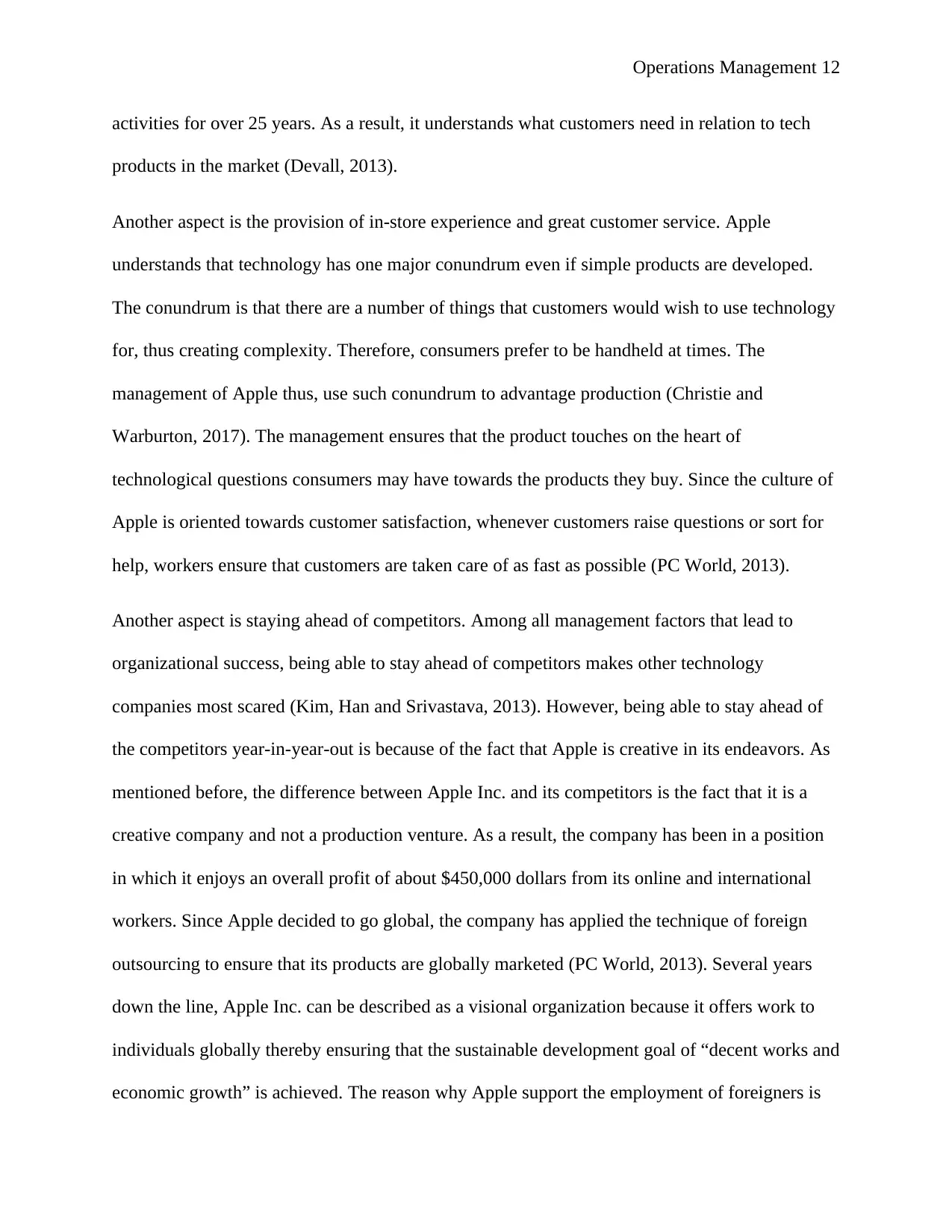
Operations Management 12
activities for over 25 years. As a result, it understands what customers need in relation to tech
products in the market (Devall, 2013).
Another aspect is the provision of in-store experience and great customer service. Apple
understands that technology has one major conundrum even if simple products are developed.
The conundrum is that there are a number of things that customers would wish to use technology
for, thus creating complexity. Therefore, consumers prefer to be handheld at times. The
management of Apple thus, use such conundrum to advantage production (Christie and
Warburton, 2017). The management ensures that the product touches on the heart of
technological questions consumers may have towards the products they buy. Since the culture of
Apple is oriented towards customer satisfaction, whenever customers raise questions or sort for
help, workers ensure that customers are taken care of as fast as possible (PC World, 2013).
Another aspect is staying ahead of competitors. Among all management factors that lead to
organizational success, being able to stay ahead of competitors makes other technology
companies most scared (Kim, Han and Srivastava, 2013). However, being able to stay ahead of
the competitors year-in-year-out is because of the fact that Apple is creative in its endeavors. As
mentioned before, the difference between Apple Inc. and its competitors is the fact that it is a
creative company and not a production venture. As a result, the company has been in a position
in which it enjoys an overall profit of about $450,000 dollars from its online and international
workers. Since Apple decided to go global, the company has applied the technique of foreign
outsourcing to ensure that its products are globally marketed (PC World, 2013). Several years
down the line, Apple Inc. can be described as a visional organization because it offers work to
individuals globally thereby ensuring that the sustainable development goal of “decent works and
economic growth” is achieved. The reason why Apple support the employment of foreigners is
activities for over 25 years. As a result, it understands what customers need in relation to tech
products in the market (Devall, 2013).
Another aspect is the provision of in-store experience and great customer service. Apple
understands that technology has one major conundrum even if simple products are developed.
The conundrum is that there are a number of things that customers would wish to use technology
for, thus creating complexity. Therefore, consumers prefer to be handheld at times. The
management of Apple thus, use such conundrum to advantage production (Christie and
Warburton, 2017). The management ensures that the product touches on the heart of
technological questions consumers may have towards the products they buy. Since the culture of
Apple is oriented towards customer satisfaction, whenever customers raise questions or sort for
help, workers ensure that customers are taken care of as fast as possible (PC World, 2013).
Another aspect is staying ahead of competitors. Among all management factors that lead to
organizational success, being able to stay ahead of competitors makes other technology
companies most scared (Kim, Han and Srivastava, 2013). However, being able to stay ahead of
the competitors year-in-year-out is because of the fact that Apple is creative in its endeavors. As
mentioned before, the difference between Apple Inc. and its competitors is the fact that it is a
creative company and not a production venture. As a result, the company has been in a position
in which it enjoys an overall profit of about $450,000 dollars from its online and international
workers. Since Apple decided to go global, the company has applied the technique of foreign
outsourcing to ensure that its products are globally marketed (PC World, 2013). Several years
down the line, Apple Inc. can be described as a visional organization because it offers work to
individuals globally thereby ensuring that the sustainable development goal of “decent works and
economic growth” is achieved. The reason why Apple support the employment of foreigners is

Operations Management 13
that Apple realized that its 14,020 American employees earned a total sum close to $800 million
while its 27,300 workers pocketed a reduced amount of about $350 million. To reduce the
amount spent o workers while increasing labor force, Apple decided to go for foreign employees
(Bullard, 2017).
However, while competitors struggle to ensure that the products they sent to the market are
competitive, Apple is developing products that will seize the market well ahead of time. For
instance, the current iPhone products that are marketed currently were designed and signed off
for sales two years back making the company in a position to design and manufacture products
that will be sold in 2020 or 2021. Such a strategy has proved to be a nightmare for competitors
and the same trend will continue for a long period (Dillon and Reif, 2014, pg. 9).
2. Resource Management
The most important stakeholders in Apple Inc. are those who work in the staff, technical, and
marketing positions in line with the objective of the company to attract and keep its workers. As
a result, Apple employs a number of human resource management strategies to attract and keep
professionals that are skilled. Apart from that, the company considers human capital as the
leading factor towards competitiveness (Devall, 2013). Proper management of the human
resource is the main reason for Apple’s productive development strategies. In most sectors of
operation, the organization has capitalized on the staff’s competencies with the main objective of
achieving a competitive advantage over other technological companies. Apple boasts of great
people and talents management approaches employed to ensure that it is the most innovative IT
organization in the technology industry (Christie and Warburton, 2017).
that Apple realized that its 14,020 American employees earned a total sum close to $800 million
while its 27,300 workers pocketed a reduced amount of about $350 million. To reduce the
amount spent o workers while increasing labor force, Apple decided to go for foreign employees
(Bullard, 2017).
However, while competitors struggle to ensure that the products they sent to the market are
competitive, Apple is developing products that will seize the market well ahead of time. For
instance, the current iPhone products that are marketed currently were designed and signed off
for sales two years back making the company in a position to design and manufacture products
that will be sold in 2020 or 2021. Such a strategy has proved to be a nightmare for competitors
and the same trend will continue for a long period (Dillon and Reif, 2014, pg. 9).
2. Resource Management
The most important stakeholders in Apple Inc. are those who work in the staff, technical, and
marketing positions in line with the objective of the company to attract and keep its workers. As
a result, Apple employs a number of human resource management strategies to attract and keep
professionals that are skilled. Apart from that, the company considers human capital as the
leading factor towards competitiveness (Devall, 2013). Proper management of the human
resource is the main reason for Apple’s productive development strategies. In most sectors of
operation, the organization has capitalized on the staff’s competencies with the main objective of
achieving a competitive advantage over other technological companies. Apple boasts of great
people and talents management approaches employed to ensure that it is the most innovative IT
organization in the technology industry (Christie and Warburton, 2017).
Paraphrase This Document
Need a fresh take? Get an instant paraphrase of this document with our AI Paraphraser
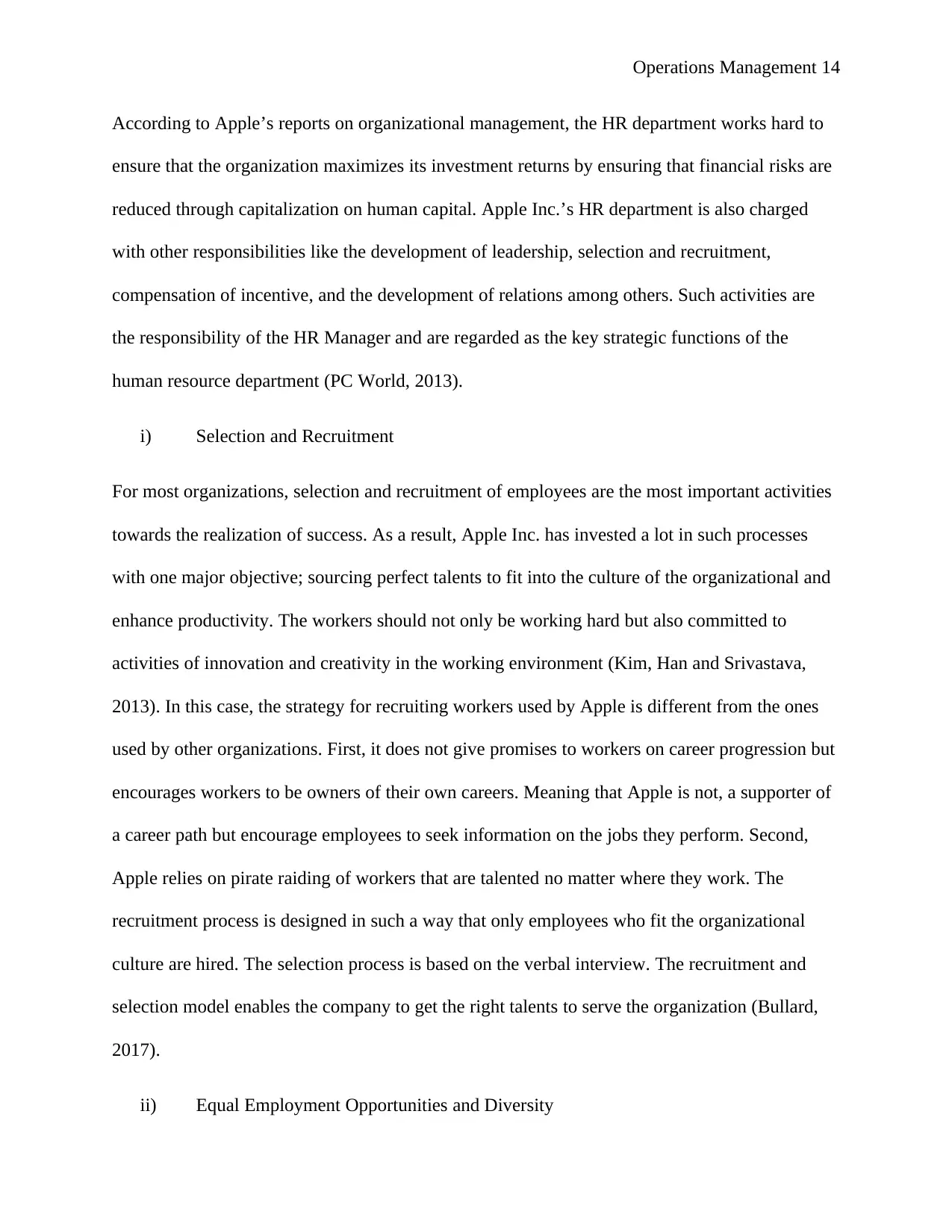
Operations Management 14
According to Apple’s reports on organizational management, the HR department works hard to
ensure that the organization maximizes its investment returns by ensuring that financial risks are
reduced through capitalization on human capital. Apple Inc.’s HR department is also charged
with other responsibilities like the development of leadership, selection and recruitment,
compensation of incentive, and the development of relations among others. Such activities are
the responsibility of the HR Manager and are regarded as the key strategic functions of the
human resource department (PC World, 2013).
i) Selection and Recruitment
For most organizations, selection and recruitment of employees are the most important activities
towards the realization of success. As a result, Apple Inc. has invested a lot in such processes
with one major objective; sourcing perfect talents to fit into the culture of the organizational and
enhance productivity. The workers should not only be working hard but also committed to
activities of innovation and creativity in the working environment (Kim, Han and Srivastava,
2013). In this case, the strategy for recruiting workers used by Apple is different from the ones
used by other organizations. First, it does not give promises to workers on career progression but
encourages workers to be owners of their own careers. Meaning that Apple is not, a supporter of
a career path but encourage employees to seek information on the jobs they perform. Second,
Apple relies on pirate raiding of workers that are talented no matter where they work. The
recruitment process is designed in such a way that only employees who fit the organizational
culture are hired. The selection process is based on the verbal interview. The recruitment and
selection model enables the company to get the right talents to serve the organization (Bullard,
2017).
ii) Equal Employment Opportunities and Diversity
According to Apple’s reports on organizational management, the HR department works hard to
ensure that the organization maximizes its investment returns by ensuring that financial risks are
reduced through capitalization on human capital. Apple Inc.’s HR department is also charged
with other responsibilities like the development of leadership, selection and recruitment,
compensation of incentive, and the development of relations among others. Such activities are
the responsibility of the HR Manager and are regarded as the key strategic functions of the
human resource department (PC World, 2013).
i) Selection and Recruitment
For most organizations, selection and recruitment of employees are the most important activities
towards the realization of success. As a result, Apple Inc. has invested a lot in such processes
with one major objective; sourcing perfect talents to fit into the culture of the organizational and
enhance productivity. The workers should not only be working hard but also committed to
activities of innovation and creativity in the working environment (Kim, Han and Srivastava,
2013). In this case, the strategy for recruiting workers used by Apple is different from the ones
used by other organizations. First, it does not give promises to workers on career progression but
encourages workers to be owners of their own careers. Meaning that Apple is not, a supporter of
a career path but encourage employees to seek information on the jobs they perform. Second,
Apple relies on pirate raiding of workers that are talented no matter where they work. The
recruitment process is designed in such a way that only employees who fit the organizational
culture are hired. The selection process is based on the verbal interview. The recruitment and
selection model enables the company to get the right talents to serve the organization (Bullard,
2017).
ii) Equal Employment Opportunities and Diversity
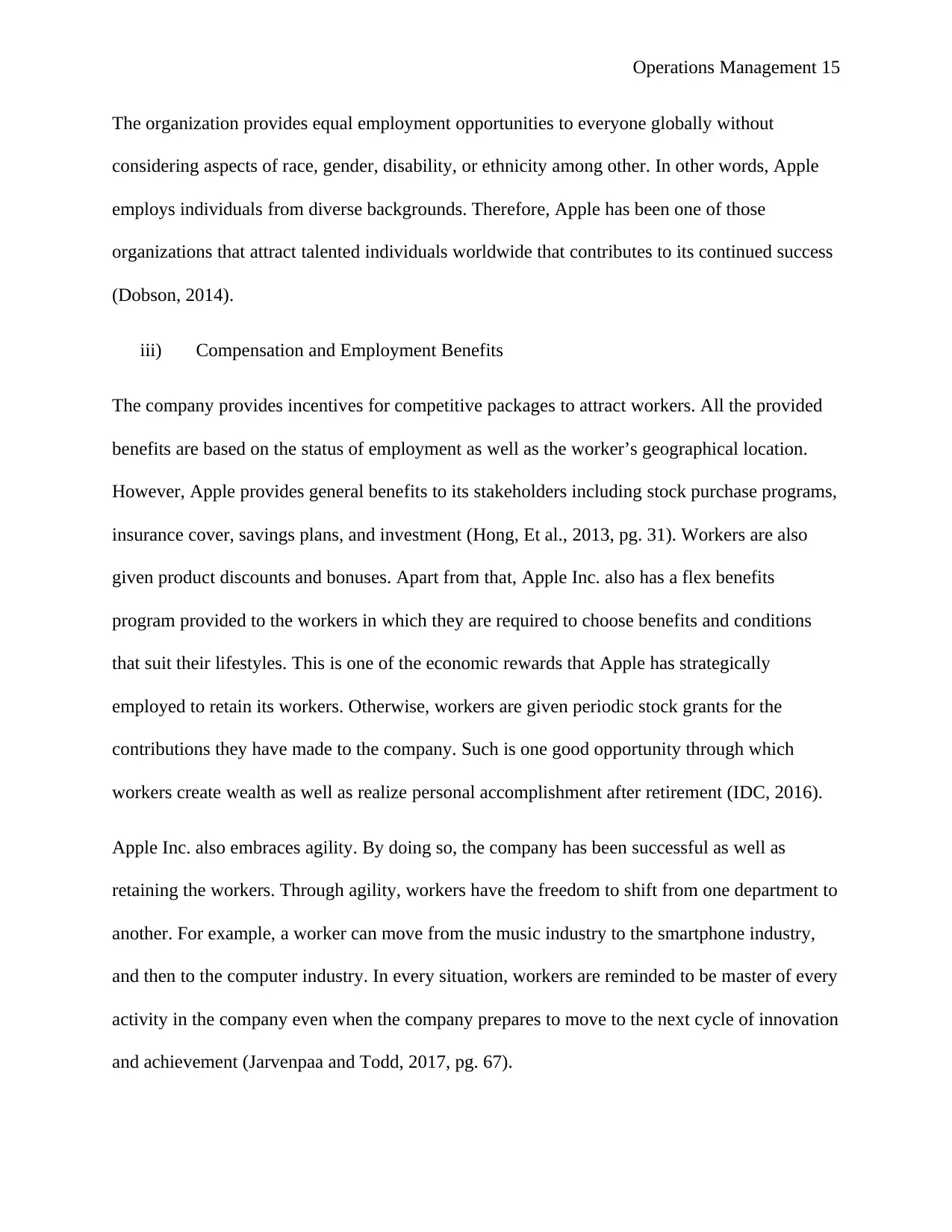
Operations Management 15
The organization provides equal employment opportunities to everyone globally without
considering aspects of race, gender, disability, or ethnicity among other. In other words, Apple
employs individuals from diverse backgrounds. Therefore, Apple has been one of those
organizations that attract talented individuals worldwide that contributes to its continued success
(Dobson, 2014).
iii) Compensation and Employment Benefits
The company provides incentives for competitive packages to attract workers. All the provided
benefits are based on the status of employment as well as the worker’s geographical location.
However, Apple provides general benefits to its stakeholders including stock purchase programs,
insurance cover, savings plans, and investment (Hong, Et al., 2013, pg. 31). Workers are also
given product discounts and bonuses. Apart from that, Apple Inc. also has a flex benefits
program provided to the workers in which they are required to choose benefits and conditions
that suit their lifestyles. This is one of the economic rewards that Apple has strategically
employed to retain its workers. Otherwise, workers are given periodic stock grants for the
contributions they have made to the company. Such is one good opportunity through which
workers create wealth as well as realize personal accomplishment after retirement (IDC, 2016).
Apple Inc. also embraces agility. By doing so, the company has been successful as well as
retaining the workers. Through agility, workers have the freedom to shift from one department to
another. For example, a worker can move from the music industry to the smartphone industry,
and then to the computer industry. In every situation, workers are reminded to be master of every
activity in the company even when the company prepares to move to the next cycle of innovation
and achievement (Jarvenpaa and Todd, 2017, pg. 67).
The organization provides equal employment opportunities to everyone globally without
considering aspects of race, gender, disability, or ethnicity among other. In other words, Apple
employs individuals from diverse backgrounds. Therefore, Apple has been one of those
organizations that attract talented individuals worldwide that contributes to its continued success
(Dobson, 2014).
iii) Compensation and Employment Benefits
The company provides incentives for competitive packages to attract workers. All the provided
benefits are based on the status of employment as well as the worker’s geographical location.
However, Apple provides general benefits to its stakeholders including stock purchase programs,
insurance cover, savings plans, and investment (Hong, Et al., 2013, pg. 31). Workers are also
given product discounts and bonuses. Apart from that, Apple Inc. also has a flex benefits
program provided to the workers in which they are required to choose benefits and conditions
that suit their lifestyles. This is one of the economic rewards that Apple has strategically
employed to retain its workers. Otherwise, workers are given periodic stock grants for the
contributions they have made to the company. Such is one good opportunity through which
workers create wealth as well as realize personal accomplishment after retirement (IDC, 2016).
Apple Inc. also embraces agility. By doing so, the company has been successful as well as
retaining the workers. Through agility, workers have the freedom to shift from one department to
another. For example, a worker can move from the music industry to the smartphone industry,
and then to the computer industry. In every situation, workers are reminded to be master of every
activity in the company even when the company prepares to move to the next cycle of innovation
and achievement (Jarvenpaa and Todd, 2017, pg. 67).
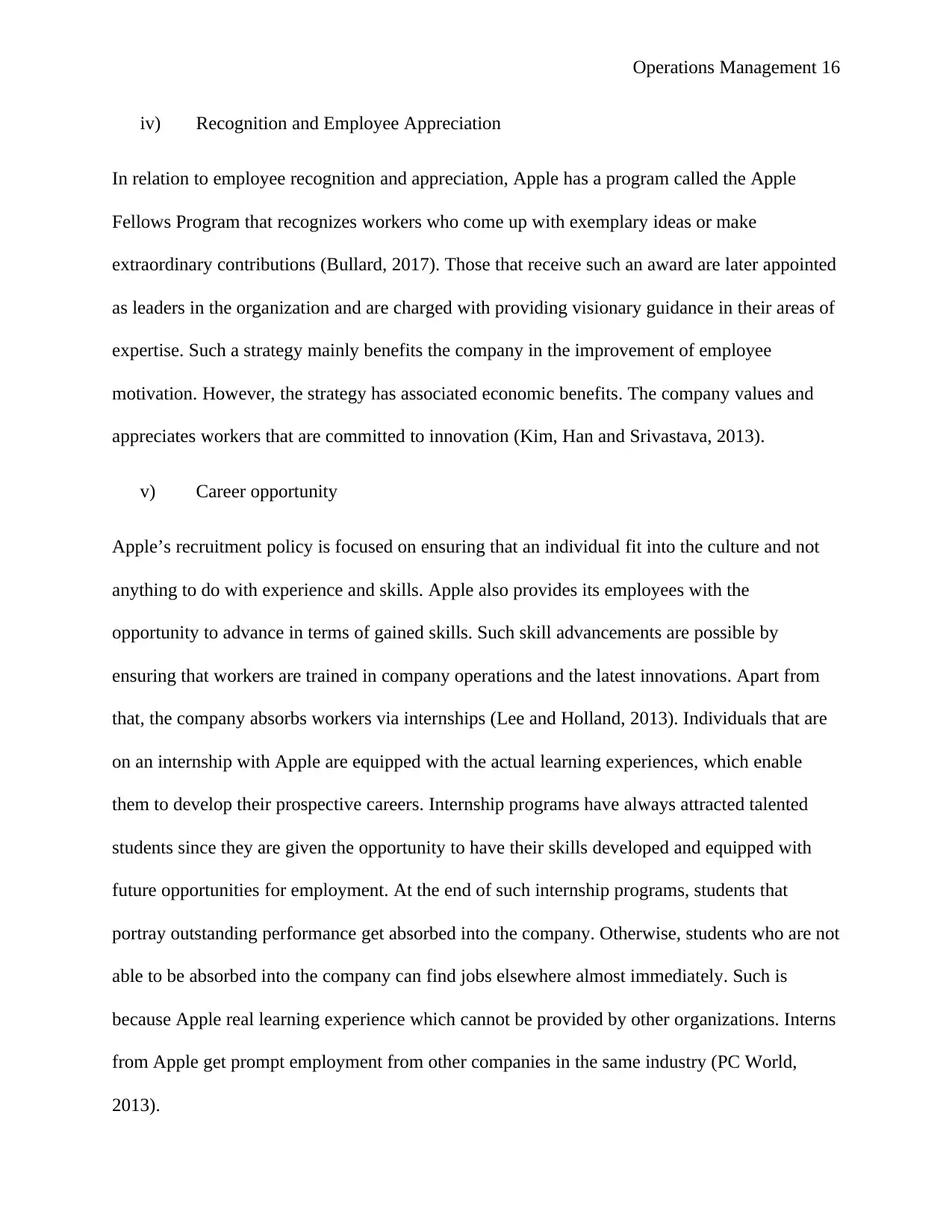
Operations Management 16
iv) Recognition and Employee Appreciation
In relation to employee recognition and appreciation, Apple has a program called the Apple
Fellows Program that recognizes workers who come up with exemplary ideas or make
extraordinary contributions (Bullard, 2017). Those that receive such an award are later appointed
as leaders in the organization and are charged with providing visionary guidance in their areas of
expertise. Such a strategy mainly benefits the company in the improvement of employee
motivation. However, the strategy has associated economic benefits. The company values and
appreciates workers that are committed to innovation (Kim, Han and Srivastava, 2013).
v) Career opportunity
Apple’s recruitment policy is focused on ensuring that an individual fit into the culture and not
anything to do with experience and skills. Apple also provides its employees with the
opportunity to advance in terms of gained skills. Such skill advancements are possible by
ensuring that workers are trained in company operations and the latest innovations. Apart from
that, the company absorbs workers via internships (Lee and Holland, 2013). Individuals that are
on an internship with Apple are equipped with the actual learning experiences, which enable
them to develop their prospective careers. Internship programs have always attracted talented
students since they are given the opportunity to have their skills developed and equipped with
future opportunities for employment. At the end of such internship programs, students that
portray outstanding performance get absorbed into the company. Otherwise, students who are not
able to be absorbed into the company can find jobs elsewhere almost immediately. Such is
because Apple real learning experience which cannot be provided by other organizations. Interns
from Apple get prompt employment from other companies in the same industry (PC World,
2013).
iv) Recognition and Employee Appreciation
In relation to employee recognition and appreciation, Apple has a program called the Apple
Fellows Program that recognizes workers who come up with exemplary ideas or make
extraordinary contributions (Bullard, 2017). Those that receive such an award are later appointed
as leaders in the organization and are charged with providing visionary guidance in their areas of
expertise. Such a strategy mainly benefits the company in the improvement of employee
motivation. However, the strategy has associated economic benefits. The company values and
appreciates workers that are committed to innovation (Kim, Han and Srivastava, 2013).
v) Career opportunity
Apple’s recruitment policy is focused on ensuring that an individual fit into the culture and not
anything to do with experience and skills. Apple also provides its employees with the
opportunity to advance in terms of gained skills. Such skill advancements are possible by
ensuring that workers are trained in company operations and the latest innovations. Apart from
that, the company absorbs workers via internships (Lee and Holland, 2013). Individuals that are
on an internship with Apple are equipped with the actual learning experiences, which enable
them to develop their prospective careers. Internship programs have always attracted talented
students since they are given the opportunity to have their skills developed and equipped with
future opportunities for employment. At the end of such internship programs, students that
portray outstanding performance get absorbed into the company. Otherwise, students who are not
able to be absorbed into the company can find jobs elsewhere almost immediately. Such is
because Apple real learning experience which cannot be provided by other organizations. Interns
from Apple get prompt employment from other companies in the same industry (PC World,
2013).
Secure Best Marks with AI Grader
Need help grading? Try our AI Grader for instant feedback on your assignments.
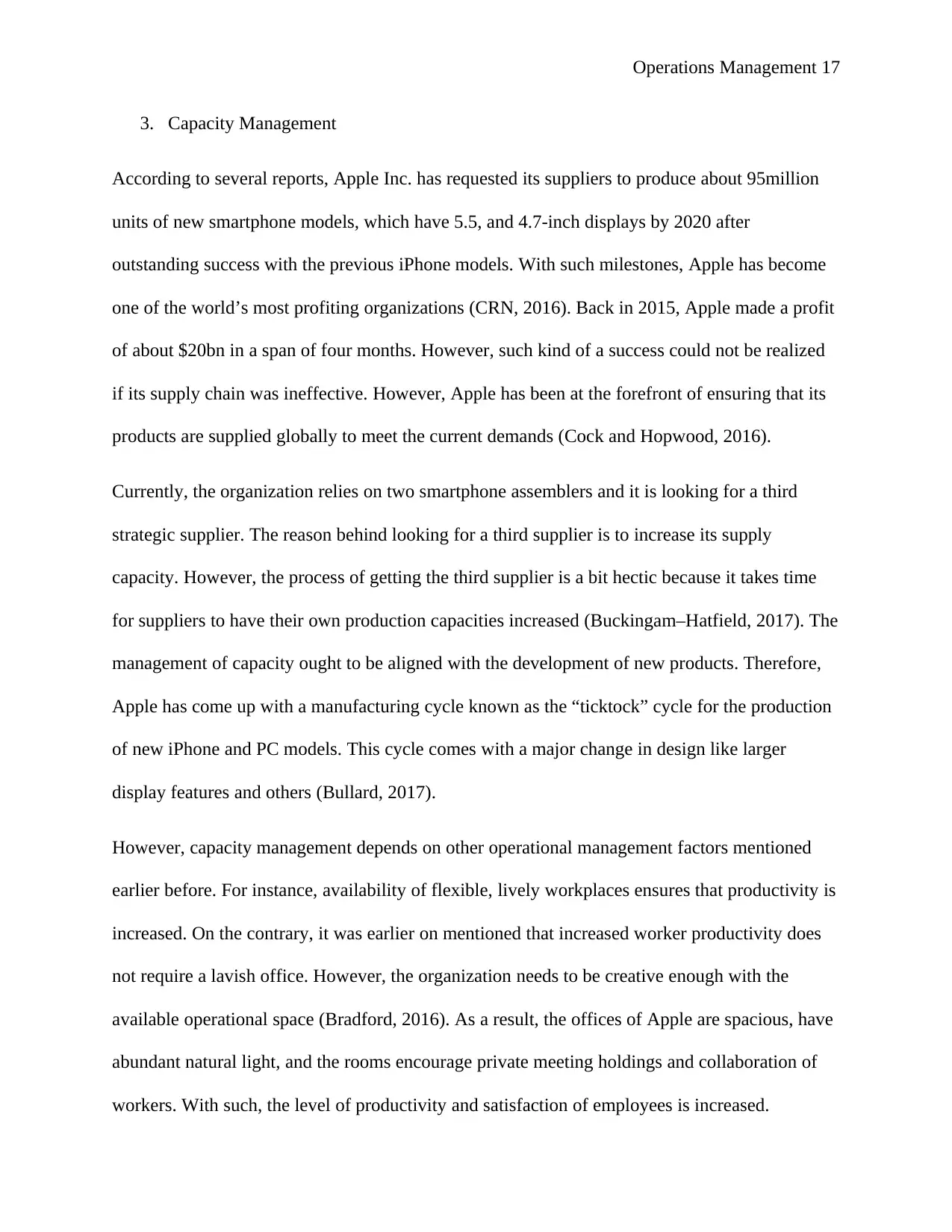
Operations Management 17
3. Capacity Management
According to several reports, Apple Inc. has requested its suppliers to produce about 95million
units of new smartphone models, which have 5.5, and 4.7-inch displays by 2020 after
outstanding success with the previous iPhone models. With such milestones, Apple has become
one of the world’s most profiting organizations (CRN, 2016). Back in 2015, Apple made a profit
of about $20bn in a span of four months. However, such kind of a success could not be realized
if its supply chain was ineffective. However, Apple has been at the forefront of ensuring that its
products are supplied globally to meet the current demands (Cock and Hopwood, 2016).
Currently, the organization relies on two smartphone assemblers and it is looking for a third
strategic supplier. The reason behind looking for a third supplier is to increase its supply
capacity. However, the process of getting the third supplier is a bit hectic because it takes time
for suppliers to have their own production capacities increased (Buckingam–Hatfield, 2017). The
management of capacity ought to be aligned with the development of new products. Therefore,
Apple has come up with a manufacturing cycle known as the “ticktock” cycle for the production
of new iPhone and PC models. This cycle comes with a major change in design like larger
display features and others (Bullard, 2017).
However, capacity management depends on other operational management factors mentioned
earlier before. For instance, availability of flexible, lively workplaces ensures that productivity is
increased. On the contrary, it was earlier on mentioned that increased worker productivity does
not require a lavish office. However, the organization needs to be creative enough with the
available operational space (Bradford, 2016). As a result, the offices of Apple are spacious, have
abundant natural light, and the rooms encourage private meeting holdings and collaboration of
workers. With such, the level of productivity and satisfaction of employees is increased.
3. Capacity Management
According to several reports, Apple Inc. has requested its suppliers to produce about 95million
units of new smartphone models, which have 5.5, and 4.7-inch displays by 2020 after
outstanding success with the previous iPhone models. With such milestones, Apple has become
one of the world’s most profiting organizations (CRN, 2016). Back in 2015, Apple made a profit
of about $20bn in a span of four months. However, such kind of a success could not be realized
if its supply chain was ineffective. However, Apple has been at the forefront of ensuring that its
products are supplied globally to meet the current demands (Cock and Hopwood, 2016).
Currently, the organization relies on two smartphone assemblers and it is looking for a third
strategic supplier. The reason behind looking for a third supplier is to increase its supply
capacity. However, the process of getting the third supplier is a bit hectic because it takes time
for suppliers to have their own production capacities increased (Buckingam–Hatfield, 2017). The
management of capacity ought to be aligned with the development of new products. Therefore,
Apple has come up with a manufacturing cycle known as the “ticktock” cycle for the production
of new iPhone and PC models. This cycle comes with a major change in design like larger
display features and others (Bullard, 2017).
However, capacity management depends on other operational management factors mentioned
earlier before. For instance, availability of flexible, lively workplaces ensures that productivity is
increased. On the contrary, it was earlier on mentioned that increased worker productivity does
not require a lavish office. However, the organization needs to be creative enough with the
available operational space (Bradford, 2016). As a result, the offices of Apple are spacious, have
abundant natural light, and the rooms encourage private meeting holdings and collaboration of
workers. With such, the level of productivity and satisfaction of employees is increased.
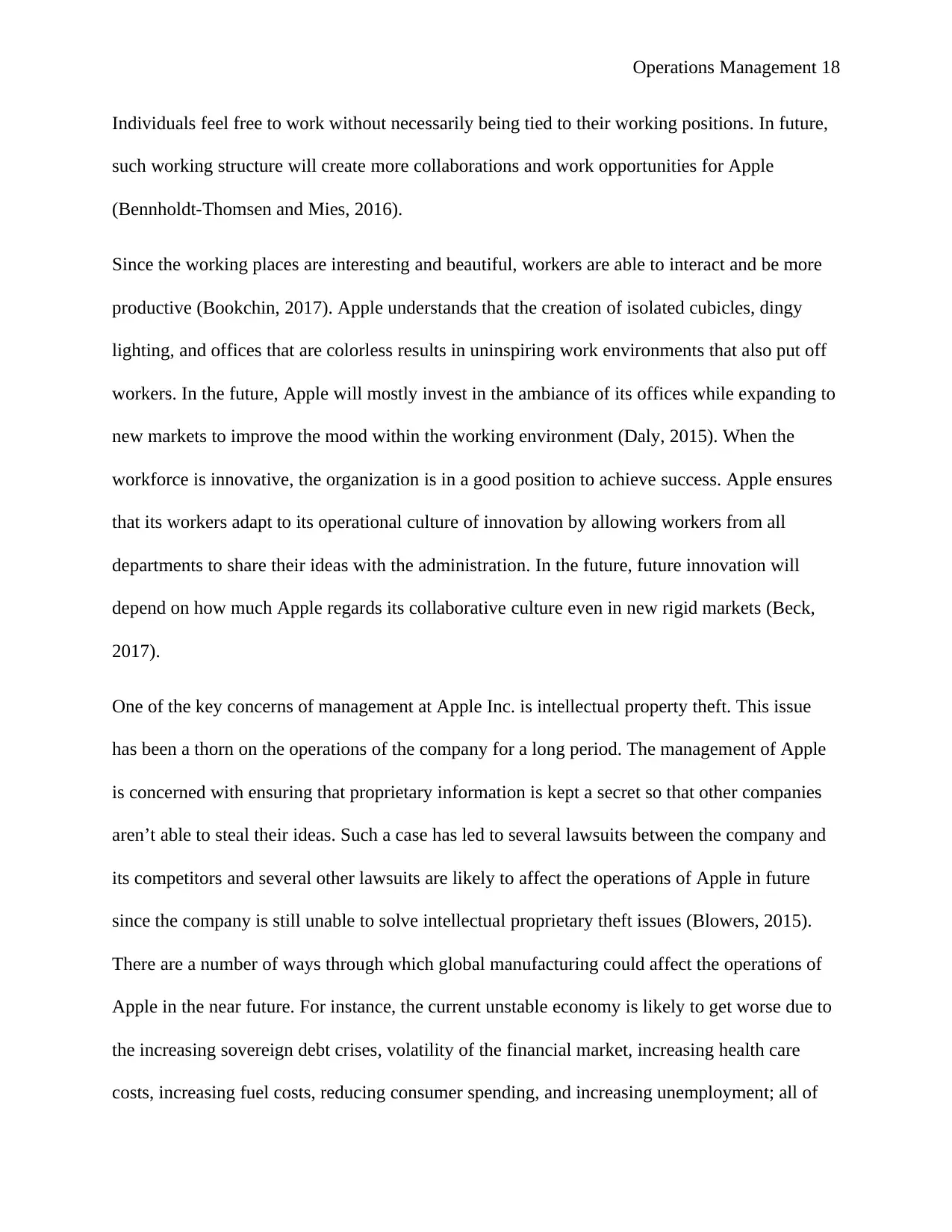
Operations Management 18
Individuals feel free to work without necessarily being tied to their working positions. In future,
such working structure will create more collaborations and work opportunities for Apple
(Bennholdt-Thomsen and Mies, 2016).
Since the working places are interesting and beautiful, workers are able to interact and be more
productive (Bookchin, 2017). Apple understands that the creation of isolated cubicles, dingy
lighting, and offices that are colorless results in uninspiring work environments that also put off
workers. In the future, Apple will mostly invest in the ambiance of its offices while expanding to
new markets to improve the mood within the working environment (Daly, 2015). When the
workforce is innovative, the organization is in a good position to achieve success. Apple ensures
that its workers adapt to its operational culture of innovation by allowing workers from all
departments to share their ideas with the administration. In the future, future innovation will
depend on how much Apple regards its collaborative culture even in new rigid markets (Beck,
2017).
One of the key concerns of management at Apple Inc. is intellectual property theft. This issue
has been a thorn on the operations of the company for a long period. The management of Apple
is concerned with ensuring that proprietary information is kept a secret so that other companies
aren’t able to steal their ideas. Such a case has led to several lawsuits between the company and
its competitors and several other lawsuits are likely to affect the operations of Apple in future
since the company is still unable to solve intellectual proprietary theft issues (Blowers, 2015).
There are a number of ways through which global manufacturing could affect the operations of
Apple in the near future. For instance, the current unstable economy is likely to get worse due to
the increasing sovereign debt crises, volatility of the financial market, increasing health care
costs, increasing fuel costs, reducing consumer spending, and increasing unemployment; all of
Individuals feel free to work without necessarily being tied to their working positions. In future,
such working structure will create more collaborations and work opportunities for Apple
(Bennholdt-Thomsen and Mies, 2016).
Since the working places are interesting and beautiful, workers are able to interact and be more
productive (Bookchin, 2017). Apple understands that the creation of isolated cubicles, dingy
lighting, and offices that are colorless results in uninspiring work environments that also put off
workers. In the future, Apple will mostly invest in the ambiance of its offices while expanding to
new markets to improve the mood within the working environment (Daly, 2015). When the
workforce is innovative, the organization is in a good position to achieve success. Apple ensures
that its workers adapt to its operational culture of innovation by allowing workers from all
departments to share their ideas with the administration. In the future, future innovation will
depend on how much Apple regards its collaborative culture even in new rigid markets (Beck,
2017).
One of the key concerns of management at Apple Inc. is intellectual property theft. This issue
has been a thorn on the operations of the company for a long period. The management of Apple
is concerned with ensuring that proprietary information is kept a secret so that other companies
aren’t able to steal their ideas. Such a case has led to several lawsuits between the company and
its competitors and several other lawsuits are likely to affect the operations of Apple in future
since the company is still unable to solve intellectual proprietary theft issues (Blowers, 2015).
There are a number of ways through which global manufacturing could affect the operations of
Apple in the near future. For instance, the current unstable economy is likely to get worse due to
the increasing sovereign debt crises, volatility of the financial market, increasing health care
costs, increasing fuel costs, reducing consumer spending, and increasing unemployment; all of

Operations Management 19
which could lead to Apple’s downfall (Bramwell, 2014). Apart from the impacts of deteriorating
global economy, the consumers of Apple goods are also likely to buy cheap pirated goods from
competitor companies. According to Apple’s management, a lot of money is spent on the designs
and development of products including the operating systems, hardware, software applications,
as well as related services. According to reports provided by Apple, its competitors skip such
manufacturing costs by copying the designs of its products thereby infringing on its intellectual
property (Archie and Carrol, 2017).
CONCLUSION
In general, this paper has discussed management issues that impact on the operations of Apple
Inc. To achieve its objectives, the work was divided into two major sections; A and B. Part A
discussed “Operations Management Issues Affecting Future Growth” of Apple Inc., while part B
discussed “Operation Management Issues to Cause Success”. However, the two sections
reflected mainly on the factors below:
- Changing Technologies
- Continued Market Globalization including the 1st and 2nd world entrants.
- Changing Employee Expectations
- Changing job designs
- Quality Management and;
- Global manufacturing
The paper, as a result, has been clear on the fact that the operations of Apple Inc. have been
beneficial to the corporation and the society. However, the company has experienced a number
of operational setbacks in relation to the discussed management factors. For instance, the
which could lead to Apple’s downfall (Bramwell, 2014). Apart from the impacts of deteriorating
global economy, the consumers of Apple goods are also likely to buy cheap pirated goods from
competitor companies. According to Apple’s management, a lot of money is spent on the designs
and development of products including the operating systems, hardware, software applications,
as well as related services. According to reports provided by Apple, its competitors skip such
manufacturing costs by copying the designs of its products thereby infringing on its intellectual
property (Archie and Carrol, 2017).
CONCLUSION
In general, this paper has discussed management issues that impact on the operations of Apple
Inc. To achieve its objectives, the work was divided into two major sections; A and B. Part A
discussed “Operations Management Issues Affecting Future Growth” of Apple Inc., while part B
discussed “Operation Management Issues to Cause Success”. However, the two sections
reflected mainly on the factors below:
- Changing Technologies
- Continued Market Globalization including the 1st and 2nd world entrants.
- Changing Employee Expectations
- Changing job designs
- Quality Management and;
- Global manufacturing
The paper, as a result, has been clear on the fact that the operations of Apple Inc. have been
beneficial to the corporation and the society. However, the company has experienced a number
of operational setbacks in relation to the discussed management factors. For instance, the
Paraphrase This Document
Need a fresh take? Get an instant paraphrase of this document with our AI Paraphraser

Operations Management 20
company lost its shares to products that are lower-priced; in particular, those that run under the
Microsoft Windows operating system. However, in spite of such challenges, the management of
Apple has ensured that the corporation enjoys profound success (Archie and Carrol, 2017).
company lost its shares to products that are lower-priced; in particular, those that run under the
Microsoft Windows operating system. However, in spite of such challenges, the management of
Apple has ensured that the corporation enjoys profound success (Archie and Carrol, 2017).
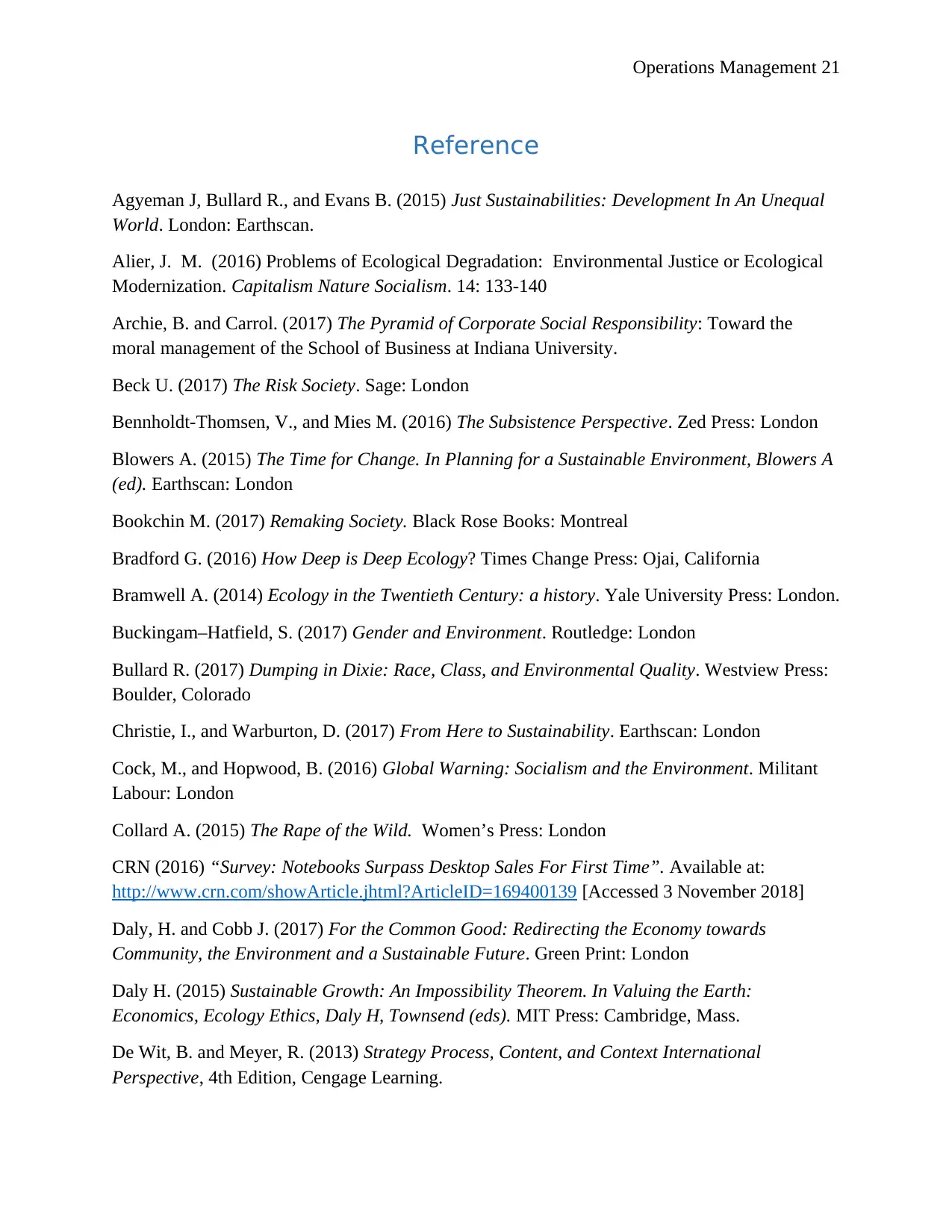
Operations Management 21
Reference
Agyeman J, Bullard R., and Evans B. (2015) Just Sustainabilities: Development In An Unequal
World. London: Earthscan.
Alier, J. M. (2016) Problems of Ecological Degradation: Environmental Justice or Ecological
Modernization. Capitalism Nature Socialism. 14: 133-140
Archie, B. and Carrol. (2017) The Pyramid of Corporate Social Responsibility: Toward the
moral management of the School of Business at Indiana University.
Beck U. (2017) The Risk Society. Sage: London
Bennholdt-Thomsen, V., and Mies M. (2016) The Subsistence Perspective. Zed Press: London
Blowers A. (2015) The Time for Change. In Planning for a Sustainable Environment, Blowers A
(ed). Earthscan: London
Bookchin M. (2017) Remaking Society. Black Rose Books: Montreal
Bradford G. (2016) How Deep is Deep Ecology? Times Change Press: Ojai, California
Bramwell A. (2014) Ecology in the Twentieth Century: a history. Yale University Press: London.
Buckingam–Hatfield, S. (2017) Gender and Environment. Routledge: London
Bullard R. (2017) Dumping in Dixie: Race, Class, and Environmental Quality. Westview Press:
Boulder, Colorado
Christie, I., and Warburton, D. (2017) From Here to Sustainability. Earthscan: London
Cock, M., and Hopwood, B. (2016) Global Warning: Socialism and the Environment. Militant
Labour: London
Collard A. (2015) The Rape of the Wild. Women’s Press: London
CRN (2016) “Survey: Notebooks Surpass Desktop Sales For First Time”. Available at:
http://www.crn.com/showArticle.jhtml?ArticleID=169400139 [Accessed 3 November 2018]
Daly, H. and Cobb J. (2017) For the Common Good: Redirecting the Economy towards
Community, the Environment and a Sustainable Future. Green Print: London
Daly H. (2015) Sustainable Growth: An Impossibility Theorem. In Valuing the Earth:
Economics, Ecology Ethics, Daly H, Townsend (eds). MIT Press: Cambridge, Mass.
De Wit, B. and Meyer, R. (2013) Strategy Process, Content, and Context International
Perspective, 4th Edition, Cengage Learning.
Reference
Agyeman J, Bullard R., and Evans B. (2015) Just Sustainabilities: Development In An Unequal
World. London: Earthscan.
Alier, J. M. (2016) Problems of Ecological Degradation: Environmental Justice or Ecological
Modernization. Capitalism Nature Socialism. 14: 133-140
Archie, B. and Carrol. (2017) The Pyramid of Corporate Social Responsibility: Toward the
moral management of the School of Business at Indiana University.
Beck U. (2017) The Risk Society. Sage: London
Bennholdt-Thomsen, V., and Mies M. (2016) The Subsistence Perspective. Zed Press: London
Blowers A. (2015) The Time for Change. In Planning for a Sustainable Environment, Blowers A
(ed). Earthscan: London
Bookchin M. (2017) Remaking Society. Black Rose Books: Montreal
Bradford G. (2016) How Deep is Deep Ecology? Times Change Press: Ojai, California
Bramwell A. (2014) Ecology in the Twentieth Century: a history. Yale University Press: London.
Buckingam–Hatfield, S. (2017) Gender and Environment. Routledge: London
Bullard R. (2017) Dumping in Dixie: Race, Class, and Environmental Quality. Westview Press:
Boulder, Colorado
Christie, I., and Warburton, D. (2017) From Here to Sustainability. Earthscan: London
Cock, M., and Hopwood, B. (2016) Global Warning: Socialism and the Environment. Militant
Labour: London
Collard A. (2015) The Rape of the Wild. Women’s Press: London
CRN (2016) “Survey: Notebooks Surpass Desktop Sales For First Time”. Available at:
http://www.crn.com/showArticle.jhtml?ArticleID=169400139 [Accessed 3 November 2018]
Daly, H. and Cobb J. (2017) For the Common Good: Redirecting the Economy towards
Community, the Environment and a Sustainable Future. Green Print: London
Daly H. (2015) Sustainable Growth: An Impossibility Theorem. In Valuing the Earth:
Economics, Ecology Ethics, Daly H, Townsend (eds). MIT Press: Cambridge, Mass.
De Wit, B. and Meyer, R. (2013) Strategy Process, Content, and Context International
Perspective, 4th Edition, Cengage Learning.
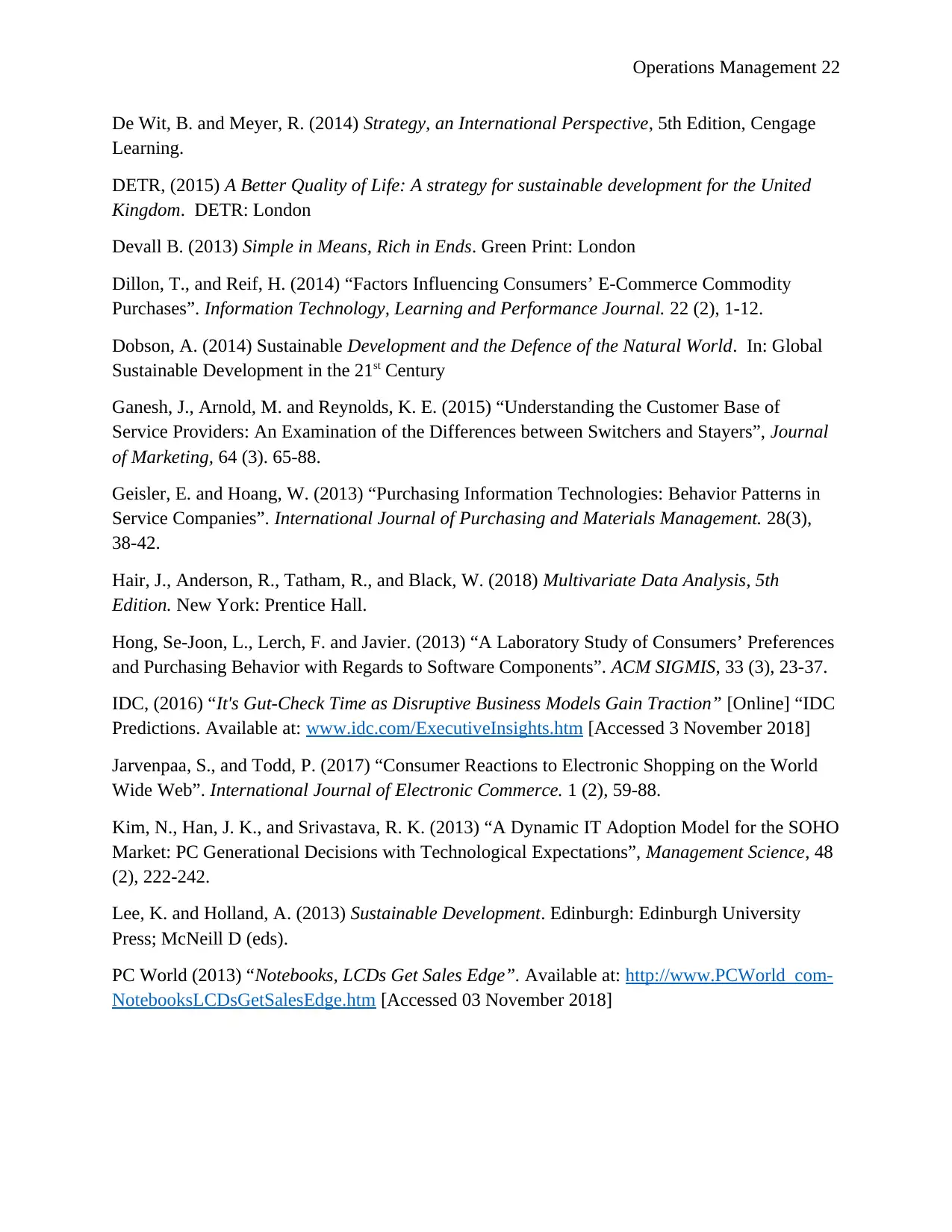
Operations Management 22
De Wit, B. and Meyer, R. (2014) Strategy, an International Perspective, 5th Edition, Cengage
Learning.
DETR, (2015) A Better Quality of Life: A strategy for sustainable development for the United
Kingdom. DETR: London
Devall B. (2013) Simple in Means, Rich in Ends. Green Print: London
Dillon, T., and Reif, H. (2014) “Factors Influencing Consumers’ E-Commerce Commodity
Purchases”. Information Technology, Learning and Performance Journal. 22 (2), 1-12.
Dobson, A. (2014) Sustainable Development and the Defence of the Natural World. In: Global
Sustainable Development in the 21st Century
Ganesh, J., Arnold, M. and Reynolds, K. E. (2015) “Understanding the Customer Base of
Service Providers: An Examination of the Differences between Switchers and Stayers”, Journal
of Marketing, 64 (3). 65-88.
Geisler, E. and Hoang, W. (2013) “Purchasing Information Technologies: Behavior Patterns in
Service Companies”. International Journal of Purchasing and Materials Management. 28(3),
38-42.
Hair, J., Anderson, R., Tatham, R., and Black, W. (2018) Multivariate Data Analysis, 5th
Edition. New York: Prentice Hall.
Hong, Se-Joon, L., Lerch, F. and Javier. (2013) “A Laboratory Study of Consumers’ Preferences
and Purchasing Behavior with Regards to Software Components”. ACM SIGMIS, 33 (3), 23-37.
IDC, (2016) “It's Gut-Check Time as Disruptive Business Models Gain Traction” [Online] “IDC
Predictions. Available at: www.idc.com/ExecutiveInsights.htm [Accessed 3 November 2018]
Jarvenpaa, S., and Todd, P. (2017) “Consumer Reactions to Electronic Shopping on the World
Wide Web”. International Journal of Electronic Commerce. 1 (2), 59-88.
Kim, N., Han, J. K., and Srivastava, R. K. (2013) “A Dynamic IT Adoption Model for the SOHO
Market: PC Generational Decisions with Technological Expectations”, Management Science, 48
(2), 222-242.
Lee, K. and Holland, A. (2013) Sustainable Development. Edinburgh: Edinburgh University
Press; McNeill D (eds).
PC World (2013) “Notebooks, LCDs Get Sales Edge”. Available at: http://www.PCWorld_com-
NotebooksLCDsGetSalesEdge.htm [Accessed 03 November 2018]
De Wit, B. and Meyer, R. (2014) Strategy, an International Perspective, 5th Edition, Cengage
Learning.
DETR, (2015) A Better Quality of Life: A strategy for sustainable development for the United
Kingdom. DETR: London
Devall B. (2013) Simple in Means, Rich in Ends. Green Print: London
Dillon, T., and Reif, H. (2014) “Factors Influencing Consumers’ E-Commerce Commodity
Purchases”. Information Technology, Learning and Performance Journal. 22 (2), 1-12.
Dobson, A. (2014) Sustainable Development and the Defence of the Natural World. In: Global
Sustainable Development in the 21st Century
Ganesh, J., Arnold, M. and Reynolds, K. E. (2015) “Understanding the Customer Base of
Service Providers: An Examination of the Differences between Switchers and Stayers”, Journal
of Marketing, 64 (3). 65-88.
Geisler, E. and Hoang, W. (2013) “Purchasing Information Technologies: Behavior Patterns in
Service Companies”. International Journal of Purchasing and Materials Management. 28(3),
38-42.
Hair, J., Anderson, R., Tatham, R., and Black, W. (2018) Multivariate Data Analysis, 5th
Edition. New York: Prentice Hall.
Hong, Se-Joon, L., Lerch, F. and Javier. (2013) “A Laboratory Study of Consumers’ Preferences
and Purchasing Behavior with Regards to Software Components”. ACM SIGMIS, 33 (3), 23-37.
IDC, (2016) “It's Gut-Check Time as Disruptive Business Models Gain Traction” [Online] “IDC
Predictions. Available at: www.idc.com/ExecutiveInsights.htm [Accessed 3 November 2018]
Jarvenpaa, S., and Todd, P. (2017) “Consumer Reactions to Electronic Shopping on the World
Wide Web”. International Journal of Electronic Commerce. 1 (2), 59-88.
Kim, N., Han, J. K., and Srivastava, R. K. (2013) “A Dynamic IT Adoption Model for the SOHO
Market: PC Generational Decisions with Technological Expectations”, Management Science, 48
(2), 222-242.
Lee, K. and Holland, A. (2013) Sustainable Development. Edinburgh: Edinburgh University
Press; McNeill D (eds).
PC World (2013) “Notebooks, LCDs Get Sales Edge”. Available at: http://www.PCWorld_com-
NotebooksLCDsGetSalesEdge.htm [Accessed 03 November 2018]
1 out of 22
Related Documents
Your All-in-One AI-Powered Toolkit for Academic Success.
+13062052269
info@desklib.com
Available 24*7 on WhatsApp / Email
![[object Object]](/_next/static/media/star-bottom.7253800d.svg)
Unlock your academic potential
© 2024 | Zucol Services PVT LTD | All rights reserved.





